Note: Originally prepared for presentation at the weekly meeting of the Gordon Allport Society, Department of Psychology, University of California, Berkeley, April 1996. My apologies for the formatting of some of the tables, which I intend to correct in the future.
Over the course of my career I have moved around a lot within psychology, but I have never strayed very far from personality and social psychology. All of my interests in cognition relate to the personal and social context in which cognition occurs, as exemplified by my work on the psychological unconscious, my collaboration with Nancy Cantor on the social intelligence view of personality, my cognitive interpretation of the self as a mental representation of oneself, and my interest in what I call the "human ecology" of memory. But I have also been interested in some problems posed by more traditional research in individual differences.
Today I'd like to share with you some recent work that began with a fairly parochial problem in hypnosis research which I pursed with two graduate students at the University of Arizona -- Martha Glisky (now in private practice in Washington State) and Doug Tataryn (now at the University of Manitoba. But the work has now started to take on somewhat broader implications, which I have continued to explore with Glisky and also Paul Trapnell, who had been a student of Jerry Wiggins at the University of British Columbia (now at the University of Winnipeg). I should say that this is a work in progress, so I welcome your comments on it.
My title, of course, is an allusion to an important paper by J.P. Guilford, published in the 1977 volume of Psychological Bulletin, in which he pointed out the dual nature of Eysenck's factor of extraversion. I have the same sort of hunch about openness to experience, the conventional label for the fifth factor in the "Big Five" solution to the structure of personality. But let me start with hypnosis.
Hypnosis
is a social interaction
in which one person, the subject,
responds to suggestions made by
another person, the hypnotist,
for imaginative experiences
involving alterations in
perception, memory,
and the voluntary control of
action. These experiences
have publicly observable
behavioral consequences, but
they are also accompanied by a
degree of subjective conviction
bordering on delusion and
feelings of involuntariness
bordering on compulsion.
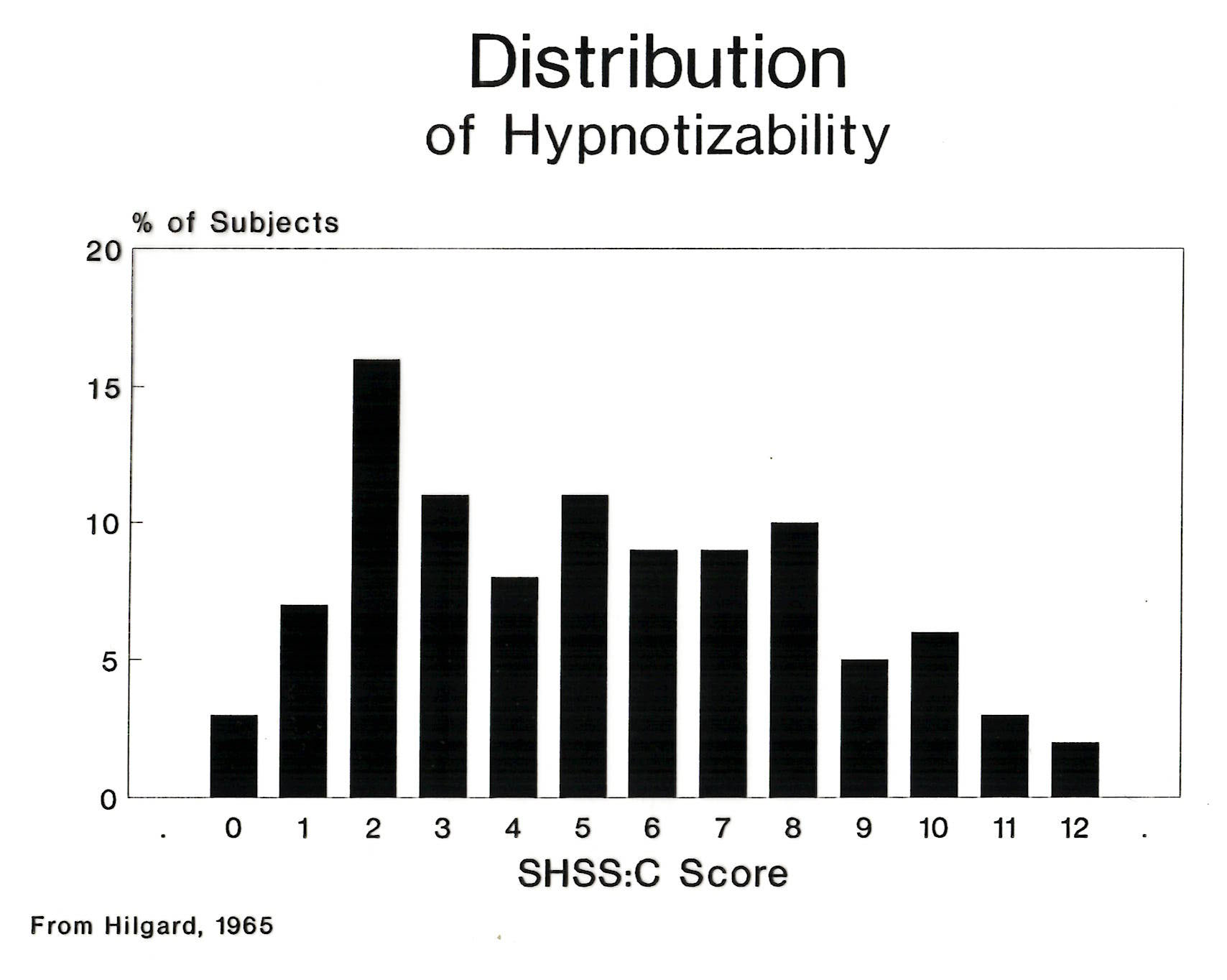 But
not every subject has these
sorts of experiences.
There are wide individual
differences in hypnotizability. these are
typically assessed based on
behavioral work-samples in
which the subject is
exposed to a standard
hypnotic induction,
including suggestions for
relaxation,
focused attention, and
eye closure; this is
followed by a series of
hypnotic
suggestions. In one
case, it is
suggested that the
subject's
outstretched
arm is growing to heavy
to keep up; in
another, that there
is a fly buzzing
annoyingly around the
subject's
face. When
response to these
suggestions is
scored according
to an objective
behavioral criterion,
we get a
quasi-normal
distribution,
skewed right
with a hint of
bimodality.
But only about
5-10% of an
unselected
sample qualify
as hypnotic
"virtuosos".
But
not every subject has these
sorts of experiences.
There are wide individual
differences in hypnotizability. these are
typically assessed based on
behavioral work-samples in
which the subject is
exposed to a standard
hypnotic induction,
including suggestions for
relaxation,
focused attention, and
eye closure; this is
followed by a series of
hypnotic
suggestions. In one
case, it is
suggested that the
subject's
outstretched
arm is growing to heavy
to keep up; in
another, that there
is a fly buzzing
annoyingly around the
subject's
face. When
response to these
suggestions is
scored according
to an objective
behavioral criterion,
we get a
quasi-normal
distribution,
skewed right
with a hint of
bimodality.
But only about
5-10% of an
unselected
sample qualify
as hypnotic
"virtuosos".
Individual differences in hypnotizability have both practical and theoretical implications. On the practical side: clinically, it only makes sense to try hypnosis with a patient who is hypnotizable; and for that matter, for many research purposes, it only makes sense to study hypnosis in subjects who can experience it. Theoretically, we'd like to know where individual differences in hypnotizability fit into the wider structure of personality.
Serious
research on the
theoretical side goes back
more than 50 years.
Some
early theorists,
like Charcot in
the 19th century,
noted the
phenotypic
similarity between
the phenomena of
hypnosis -- paralyses,
motor automatisms, sensory
anesthesias, amnesia
-- and the symptoms
of hysteria, and
proposed that
neurotic individuals
were relatively
highly hypnotizable.
We now know that
this
is false: in
general, mentally
ill people are less
responsive to
hypnosis.
Even a tendency
to have dissociative
experiences doesn't
predict
hypnotizability very
well.
Later,
Rosenzweig and Sarason
(1942a, 1942b) proposed
a "triadic hypothesis"
that hypnotizability is
highest when the
individual prefers
repression as a defense,
and characteristically
responses to frustration
with
intropunitiveness.
But this hypothesis
never went anywhere,
because of difficult
measurement
problems. Maybe
things would be
different now that Dan
Weinberger has developed
a measure of repressive
style, and Lyn Abramson
and her colleagues have
introduced the notion of
attributional
style. But still,
there's never been any
followup.
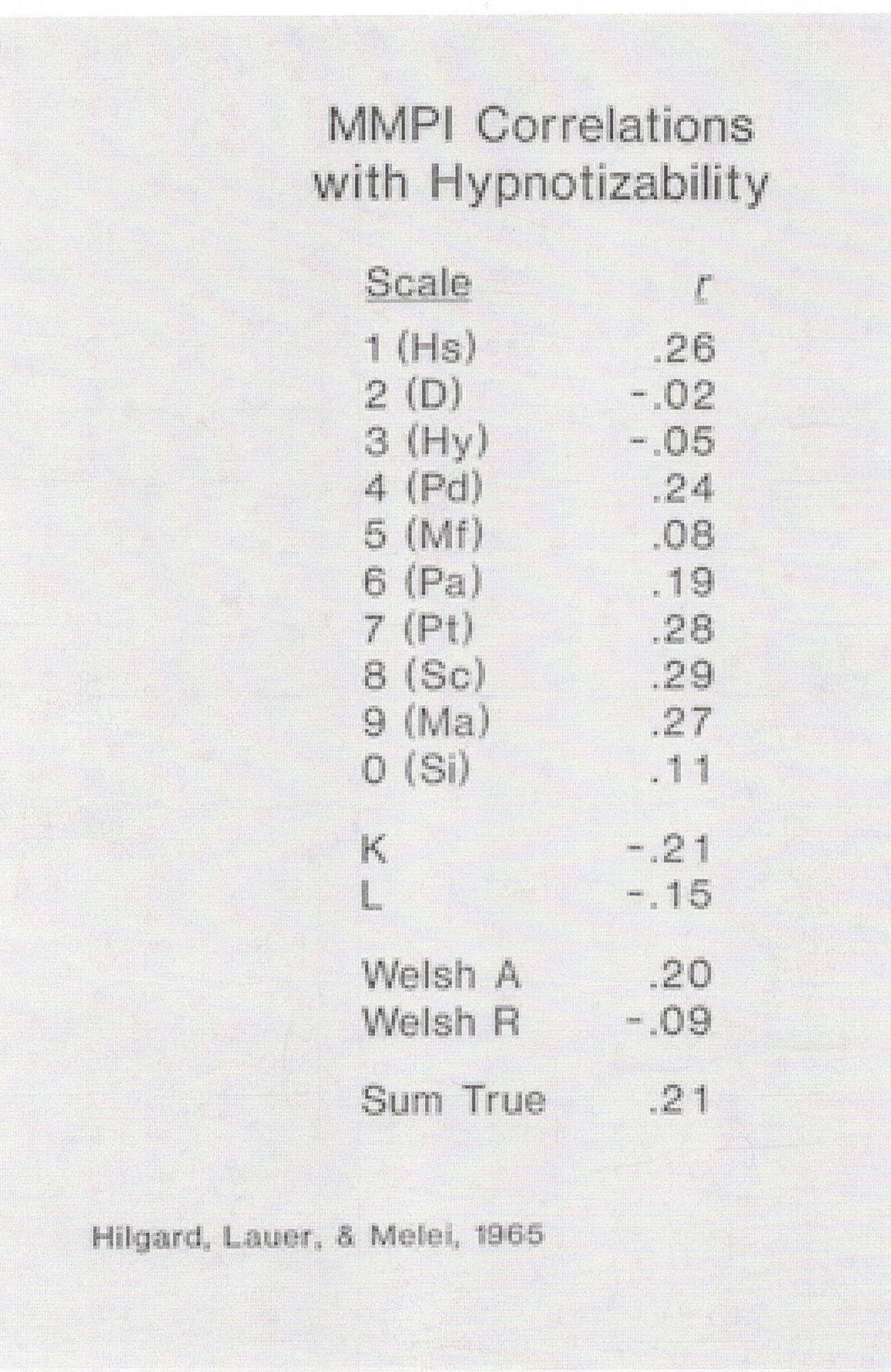 In
In 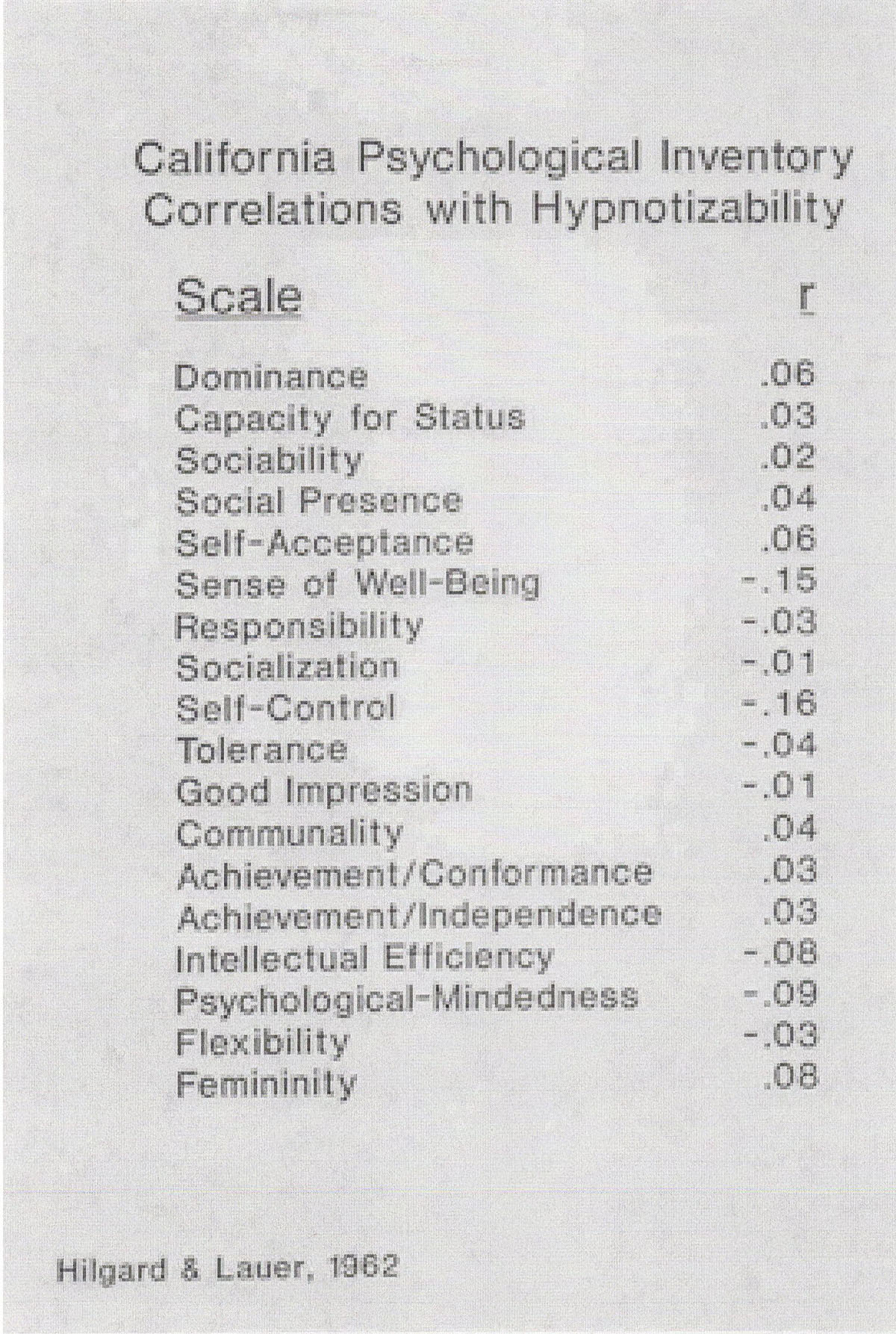 the 1950s and
1960s there were a large number of studies employing various personality
inventories such as the MMPI and the CPI, but these
investigations generally yielded nothing -- most of the
correlations in question didn't even get up to Mischel's
"personality coefficient". There was just nothing
there at all.
the 1950s and
1960s there were a large number of studies employing various personality
inventories such as the MMPI and the CPI, but these
investigations generally yielded nothing -- most of the
correlations in question didn't even get up to Mischel's
"personality coefficient". There was just nothing
there at all.
Things began to change in the 1960s, with the introduction of new questionnaires (and interviews) designed to measure "hypnosis-like" experiences which occur in the ordinary course of everyday living (As; Shor; J.R. Hilgard). The best known of these is the Absorption Scale developed by Tellegen and Atkinson (1974).
Originally, T&A defined
absorption as "the full commitment of available
perceptual, motoric, imaginative, and ideational resources
to a unified representation of the attentional object"
(Tellegen & Atkinson,
1974).
More recently, Tellegen (1987) defined absorption as "A disposition, penchant, or readiness to enter states characterized by marked cognitive restructuring, experienced as a dissociative narrowing of attention or as a peak experience involving expanded attention; a readiness to depart from more everyday cognitive maps and to restructure also in the process one's representation of one's self and its boundaries".
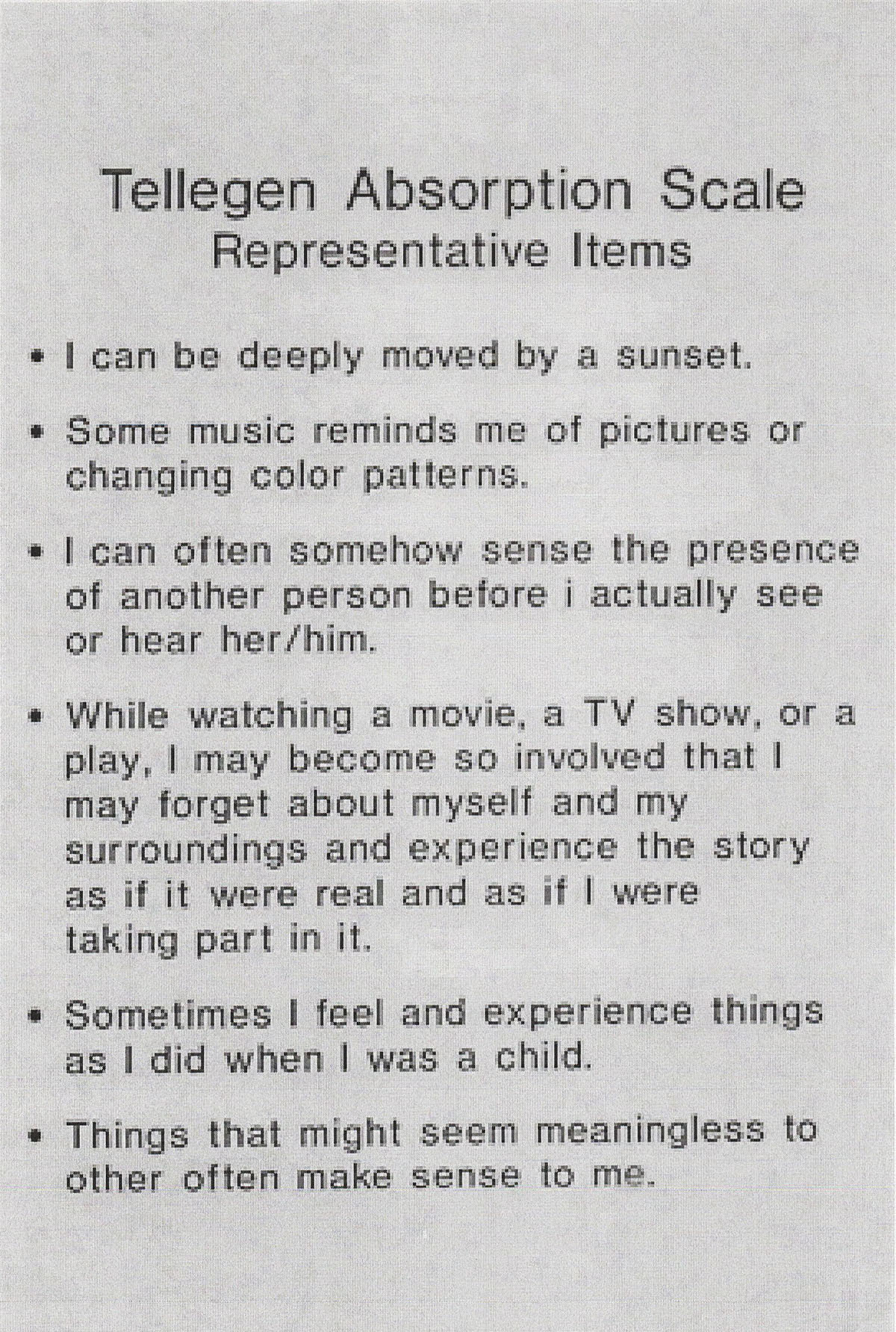 The
The
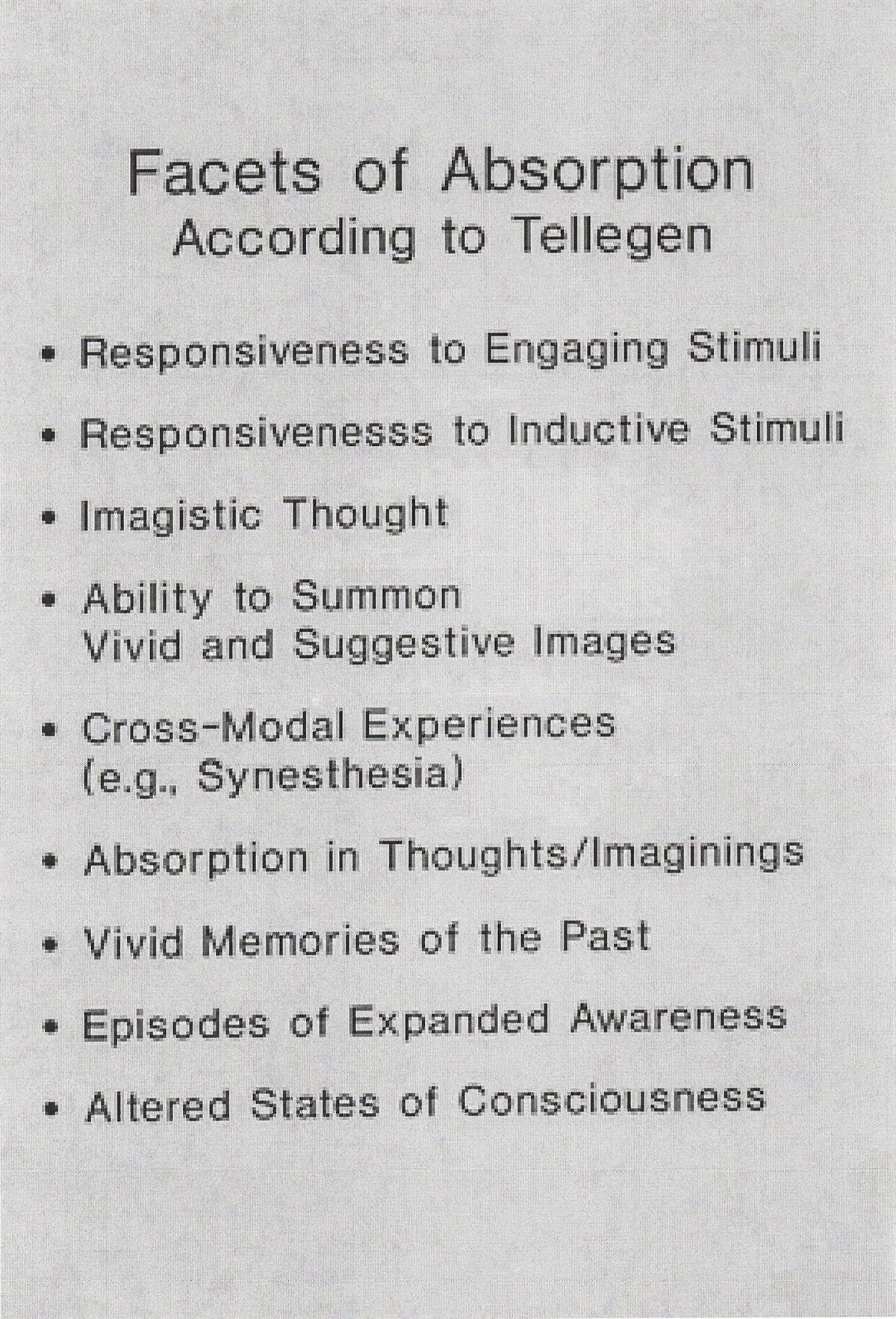 34-item
Tellegen Absorption Scale (TAS), part of Tellegen's
Multidimensional Personality Questionnaire, measures a wide variety of
experiences.
34-item
Tellegen Absorption Scale (TAS), part of Tellegen's
Multidimensional Personality Questionnaire, measures a wide variety of
experiences.
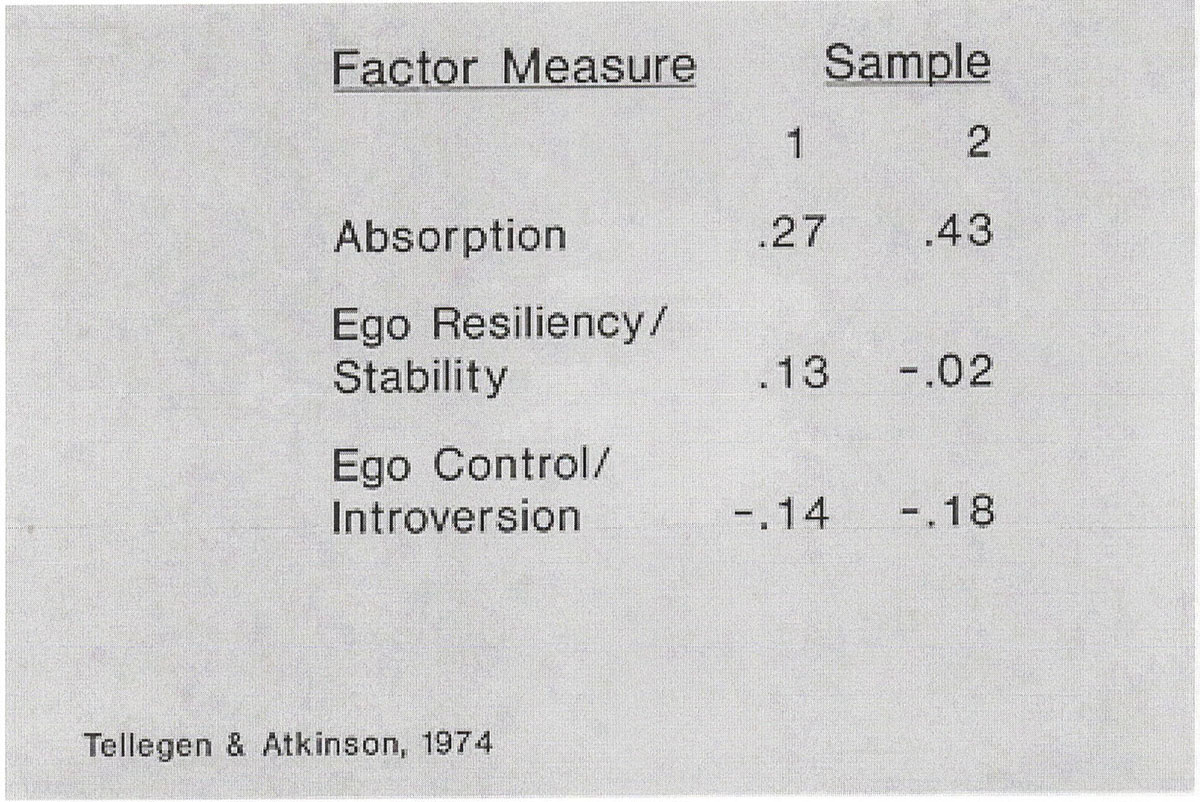 Tellegen's original study found that
TAS scores correlated moderately highly with
hypnotizability, especially compared with
standard traits like ego resiliency
(neuroticism) and ego control
(extraversion-introversion).
Tellegen's original study found that
TAS scores correlated moderately highly with
hypnotizability, especially compared with
standard traits like ego resiliency
(neuroticism) and ego control
(extraversion-introversion).
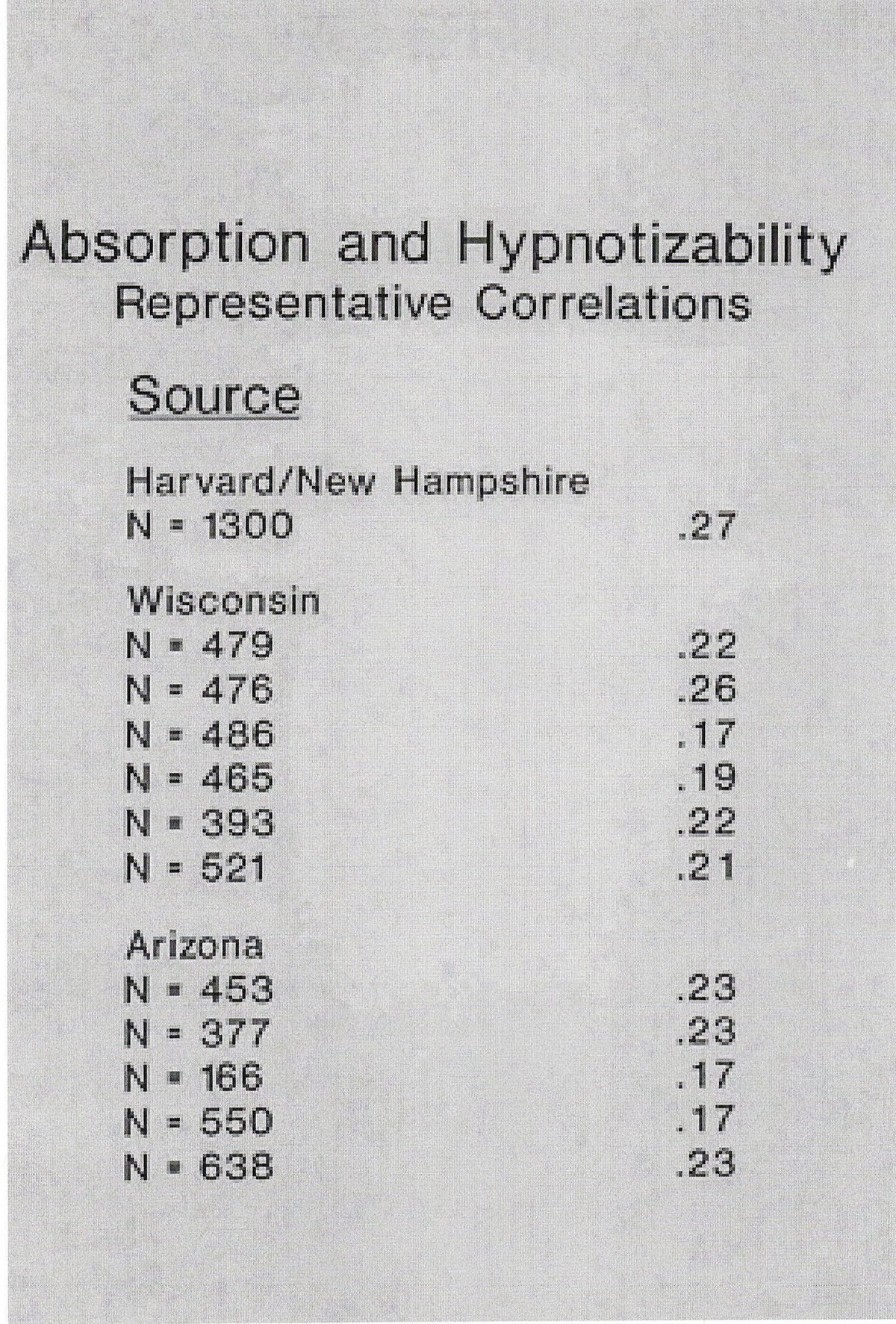 Data
Data 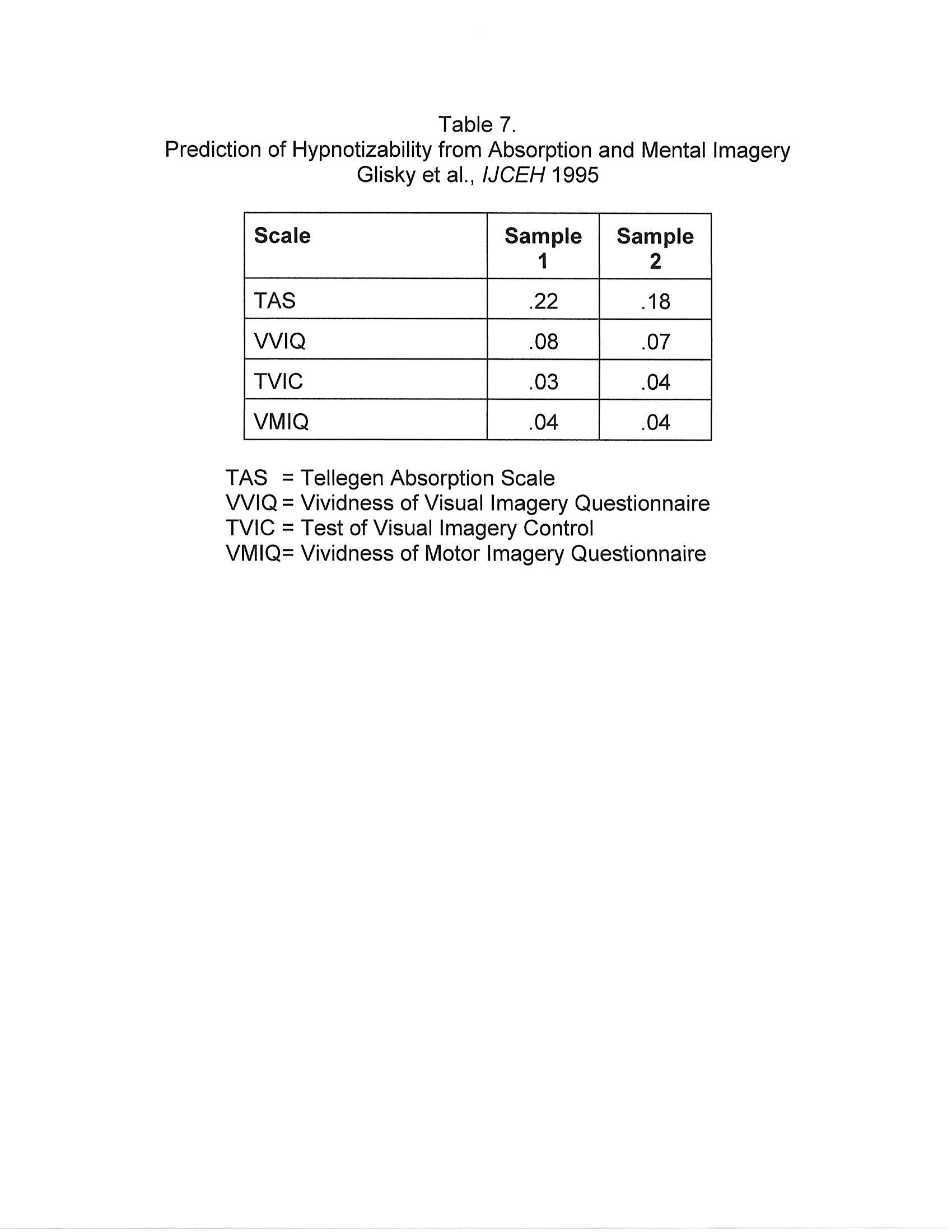 from my laboratory,
gathered during routine screening of
hypnotizability, also showed consistent
correlations with TAS -- though not as high as the
original figures from Tellegen &
Atkinson. In medicine, there's an old saying, sometimes
attributed to Hippocrates, that physicians should
use drugs quickly, while they still have their
effects. Maybe the same principle
applies to personality questionnaires! But
still, it's possible to get even smaller
correlations with other plausible
predictors. For example, in one study
two large samples totaling 1,532
subjects completed TAS and a variety of
imagery scales prior to hypnosis (Glisky
et al., 1995). The correlation
between hypnotizability and absorption
was far greater than the
corresponding correlations involving
the imagery scales.
from my laboratory,
gathered during routine screening of
hypnotizability, also showed consistent
correlations with TAS -- though not as high as the
original figures from Tellegen &
Atkinson. In medicine, there's an old saying, sometimes
attributed to Hippocrates, that physicians should
use drugs quickly, while they still have their
effects. Maybe the same principle
applies to personality questionnaires! But
still, it's possible to get even smaller
correlations with other plausible
predictors. For example, in one study
two large samples totaling 1,532
subjects completed TAS and a variety of
imagery scales prior to hypnosis (Glisky
et al., 1995). The correlation
between hypnotizability and absorption
was far greater than the
corresponding correlations involving
the imagery scales.
Still, the correlation with TAS still do not exceed Mischel's (968) personality coefficient. As theoretically interesting as they may be, they're useless for the prediction of an individual's response to hypnosis. There is no substitute for the actual measurement of hypnotizability. Still TAS gives us something to work with theoretically, and that's where I want to turn my attention next. The fact that none of the MMPI or CPI scales correlated with hypnotizability suggested that absorption represented a new dimension of personality. And it's at this point that the literature on hypnotizability begins to encounter the literature on personality structure.
There followed a series of
studies of the trait lexicon, assuming that the
important dimensions of personality were encoded in language (a
kind of personological variant on Zipf's Law
that common objects, activities, and qualities are
encoded in language as single, short words).
The starting=point for this research was a list of 17,953 personality trait terms identified by Allport and Odbert (1937) in an unabridged English dictionary (actually, there were 17,954 such terms, A&O having misnumbered their list). Raymond B. Cattell. working from this list, and eliminating synonyms and near-synonyms, identified a personality sphere consisting of 15-20 personality factors represented in ordinary language, which formed the basis for his 16PF questionnaire.
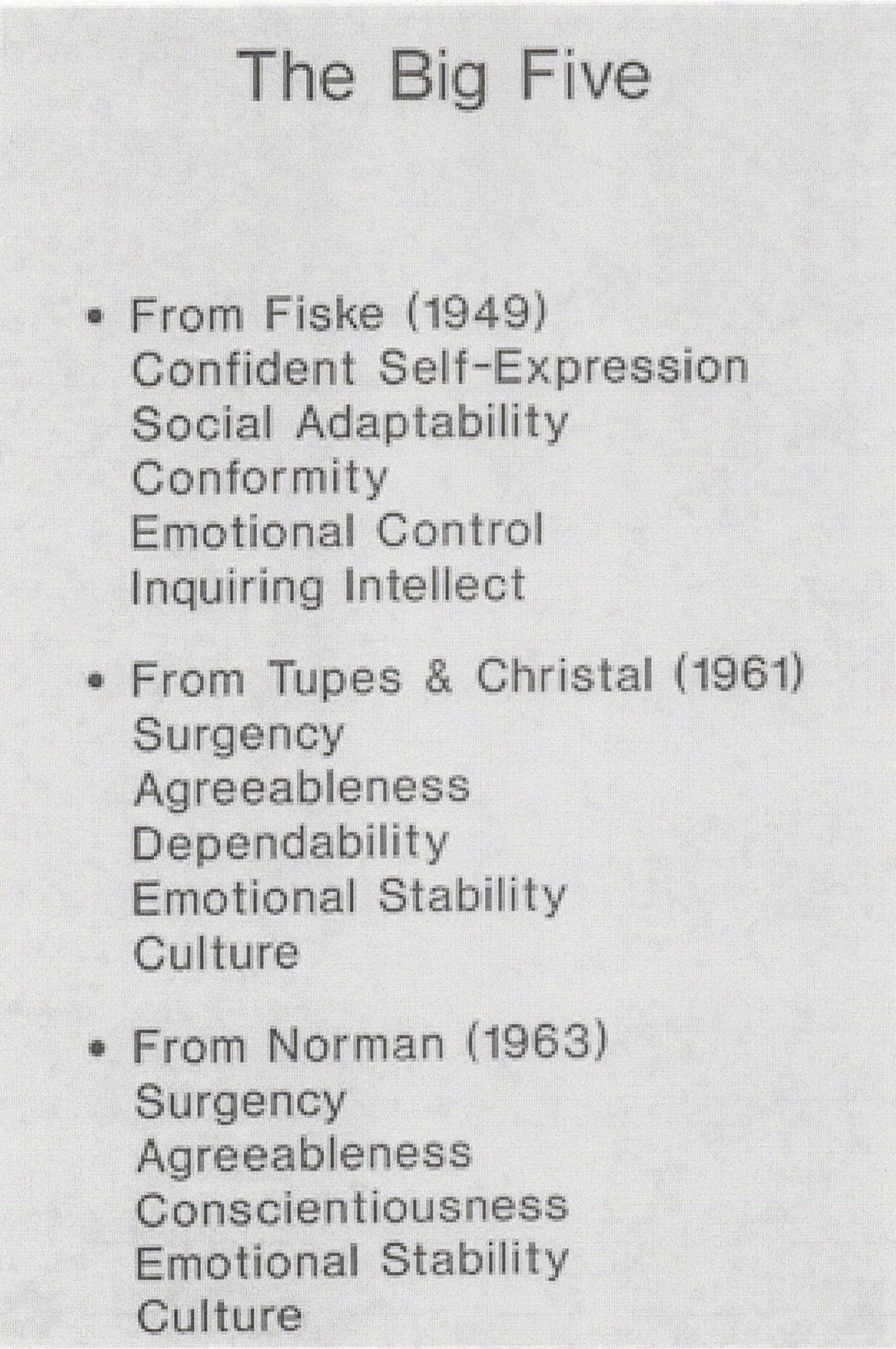 Later
work began with the same adjective set, but reduced the
personality sphere to a smaller number of dimensions --
namely five, and it's the fifth one that especially
interests me.
Later
work began with the same adjective set, but reduced the
personality sphere to a smaller number of dimensions --
namely five, and it's the fifth one that especially
interests me.
For that reason, I call the Big Five the "Big Five Blind Date Questions", because hey seem to represent the fundamental things you want to know about someone whom you're going to spend some time with: Is s/he outgoing? Friendly? Reliable? Crazy? Smart?
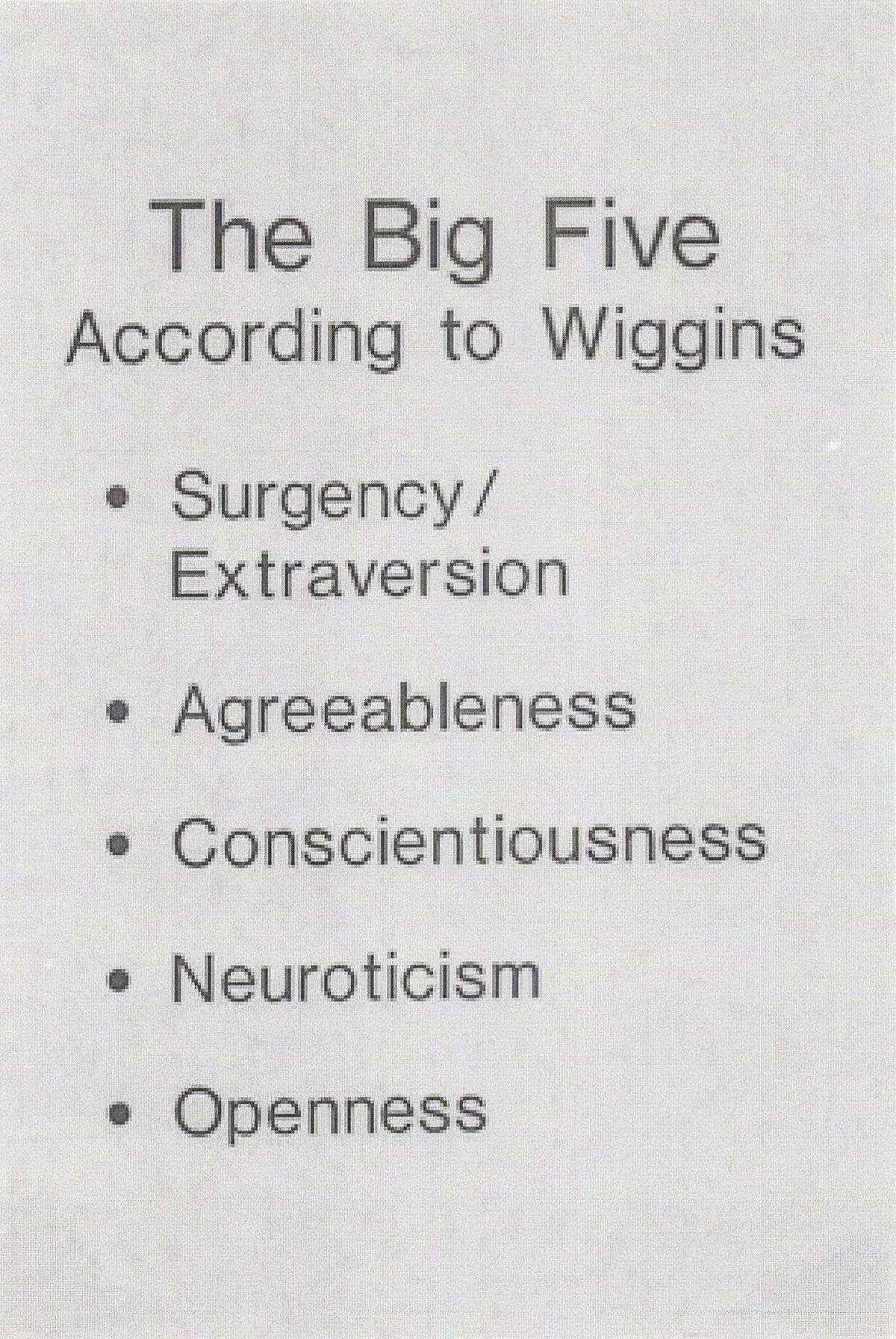 The
consistency with which various investigators
(albeit all at Michigan!) extracted
the Big Five is impression,
but it's important to note that all these
studies had a common source: the original
list of 171 terms culled by Cattell from the
A&O list. The reduction from
17,954 to 171 reflects an awful lot of
pre-selection, which of course was required
by the mechanical constraints on
computer
speed and memory at the time.
This
problem was largely solved by 1963, and
accordingly research started all over
again.
The
consistency with which various investigators
(albeit all at Michigan!) extracted
the Big Five is impression,
but it's important to note that all these
studies had a common source: the original
list of 171 terms culled by Cattell from the
A&O list. The reduction from
17,954 to 171 reflects an awful lot of
pre-selection, which of course was required
by the mechanical constraints on
computer
speed and memory at the time.
This
problem was largely solved by 1963, and
accordingly research started all over
again.
But still, there were problems.
The criteria used in culling the item set was somewhat
subjective. And the ratio of subjects (N=186) to items
(1,710) in the Goldberg study is probably too small to
yield a stable solution. I understand from
Auke Tellegen that he has addressed the first
problem by employing a 10% probability sample of the
entire trait lexicon, and again got the Big
Five.
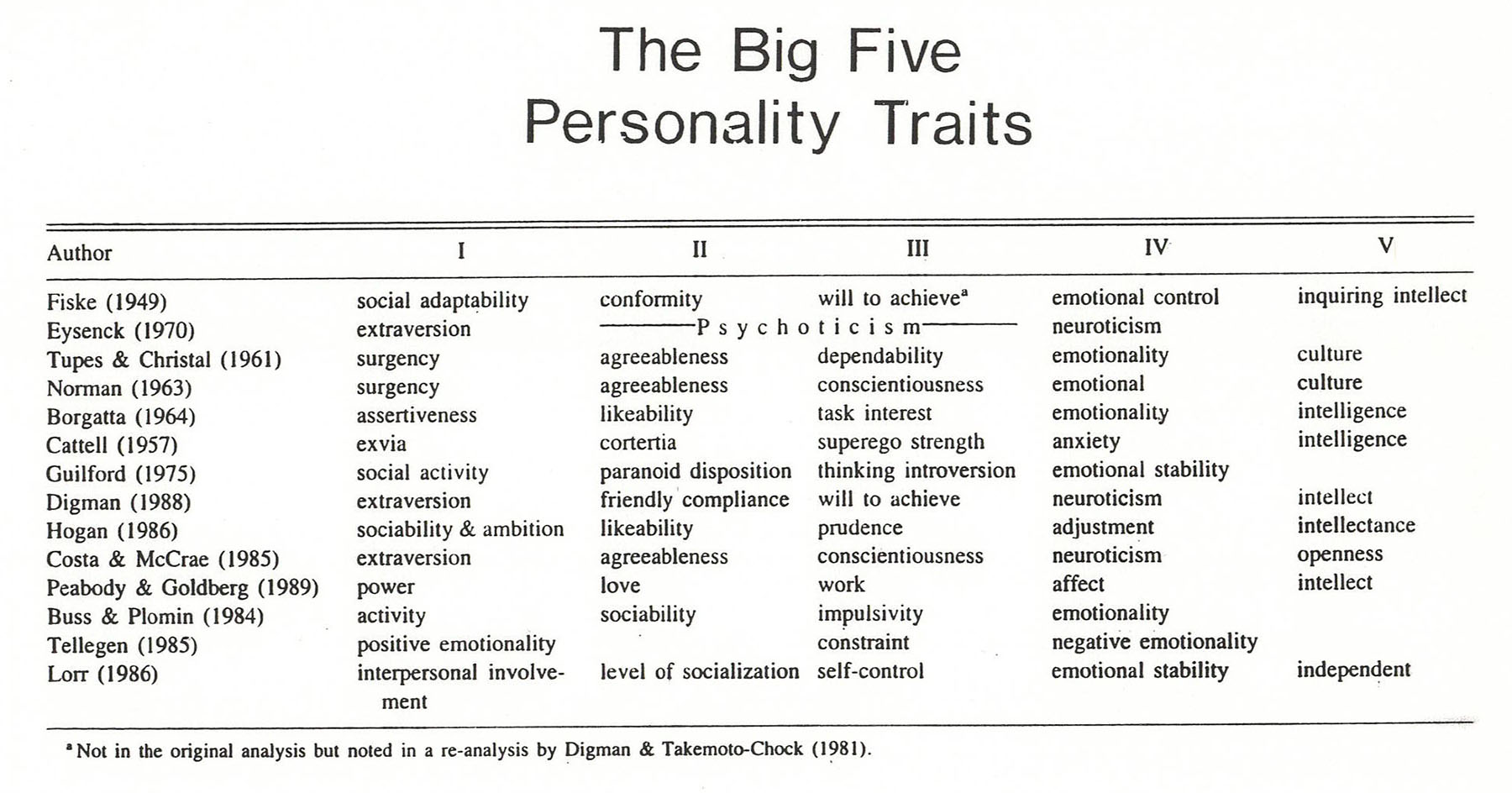 So we really see to have
settled the question of the structure of
personality, which really does seem to
consist of five factors closely resembling
Norman's:
So we really see to have
settled the question of the structure of
personality, which really does seem to
consist of five factors closely resembling
Norman's:
- Extraversion
- Neuroticism
- Agreeableness
- Conscientiousness
- Openness.
Of course, we need to extend this evidentiary base to other languages, in order to determine whether it is really universal, as Norman claimed. But in the meantime, we can use the Big Five for a wide variety of studies -- behavior genetics, cross-cultural and life-span comparisons, and the like. To this end, McCrae and Costa (hereafter, "McCosta") have developed a series of self-report questionnaires assessing the Big Five in terms of behavioral-self-descriptions. Still, some questions remain, namely:
With respect to the first question, the number of factors, a number of different solutions have been proposed.
As to their labels,
there has been
pretty good agreement on four of the Big Five. But
the definition of Factor V has been problematic right
from the start.
All of the work described so far was based on adjective rating scales. What about the other principal method for personality assessment, self-report questionnaires?
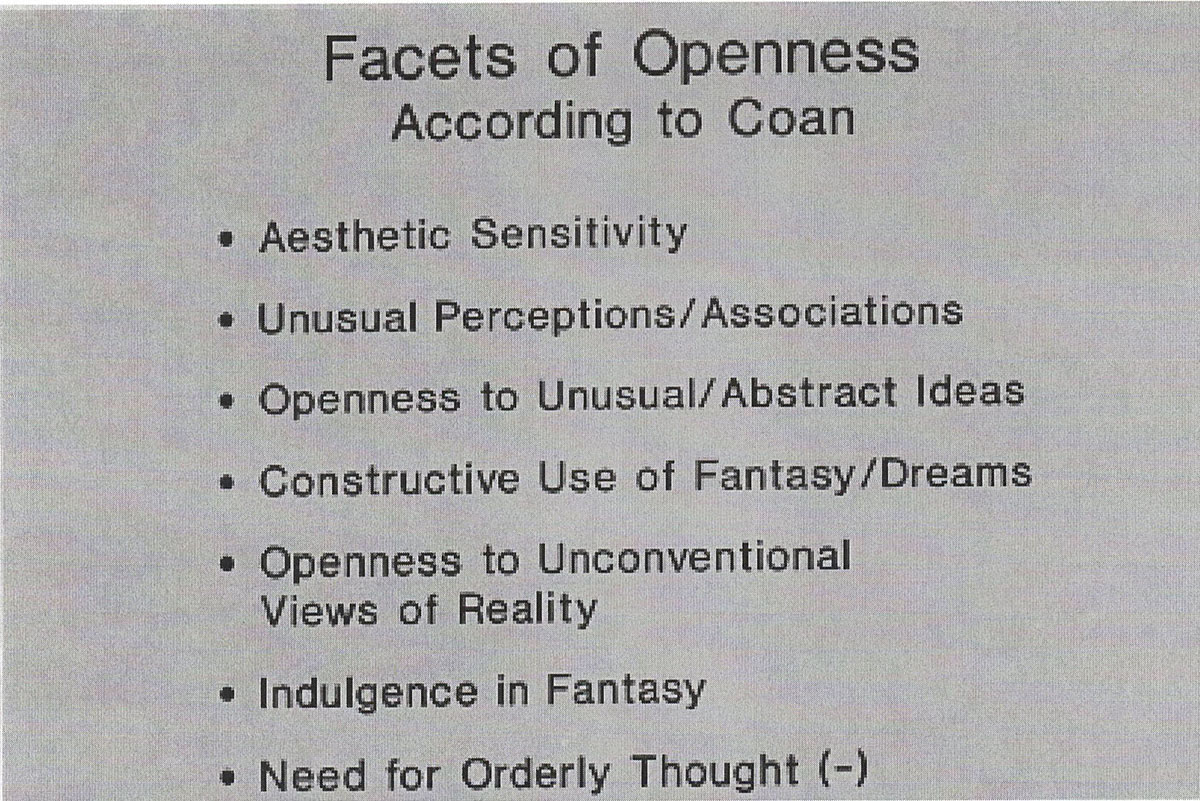 This
This
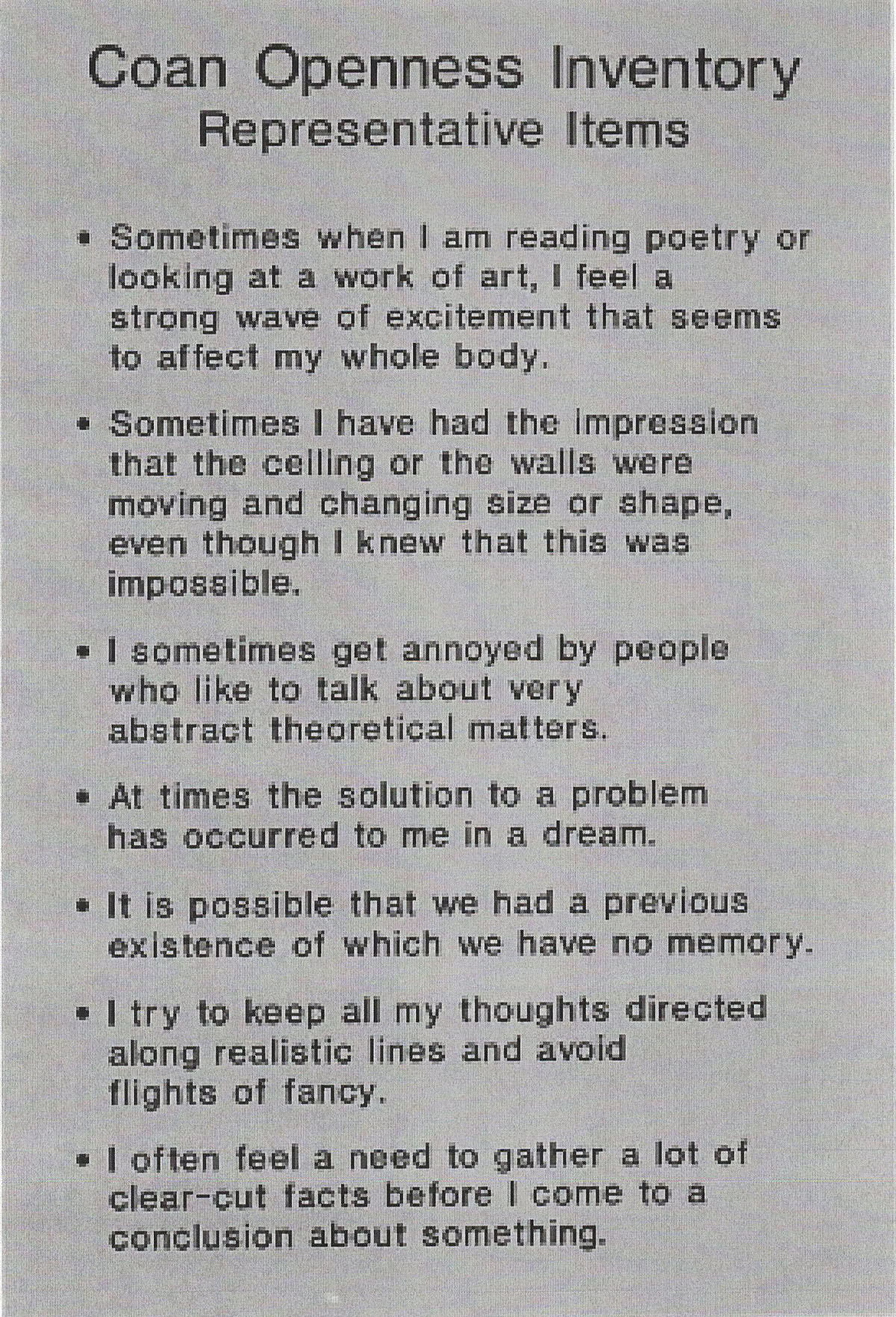 line
of research seems to begin with Richard Coan (1974), a
former colleague of mine at Arizona, who conducted a
reanalysis of Cattell's 16PF as part of his ongoing
research on the "optimal personality". Coan
viewed mental health as a positive quality, not just
the absence of neuroticism and psychoticism, and he
identified a cluster of items which he called openness
to experience, and developed a new instrument, the
Coan Experience Inventory (CEI), to measure this dimension of
personality.
line
of research seems to begin with Richard Coan (1974), a
former colleague of mine at Arizona, who conducted a
reanalysis of Cattell's 16PF as part of his ongoing
research on the "optimal personality". Coan
viewed mental health as a positive quality, not just
the absence of neuroticism and psychoticism, and he
identified a cluster of items which he called openness
to experience, and developed a new instrument, the
Coan Experience Inventory (CEI), to measure this dimension of
personality.
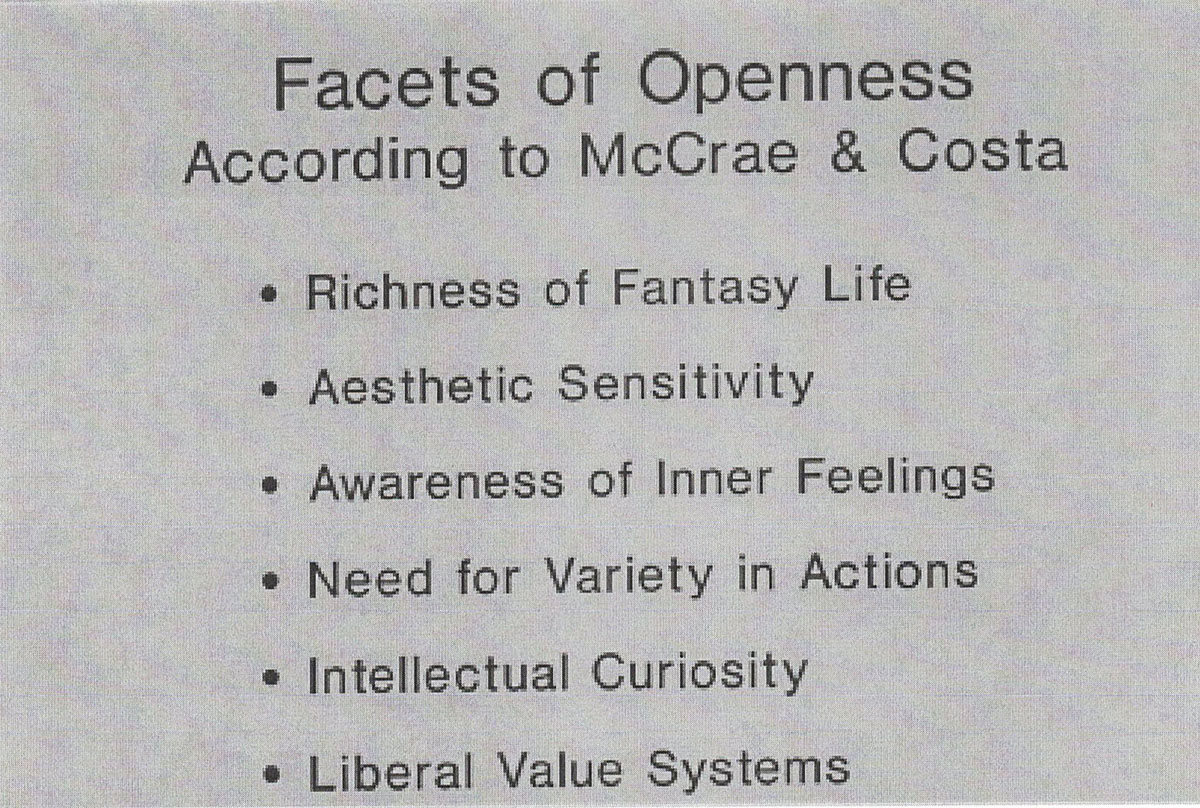 McCrae
McCrae 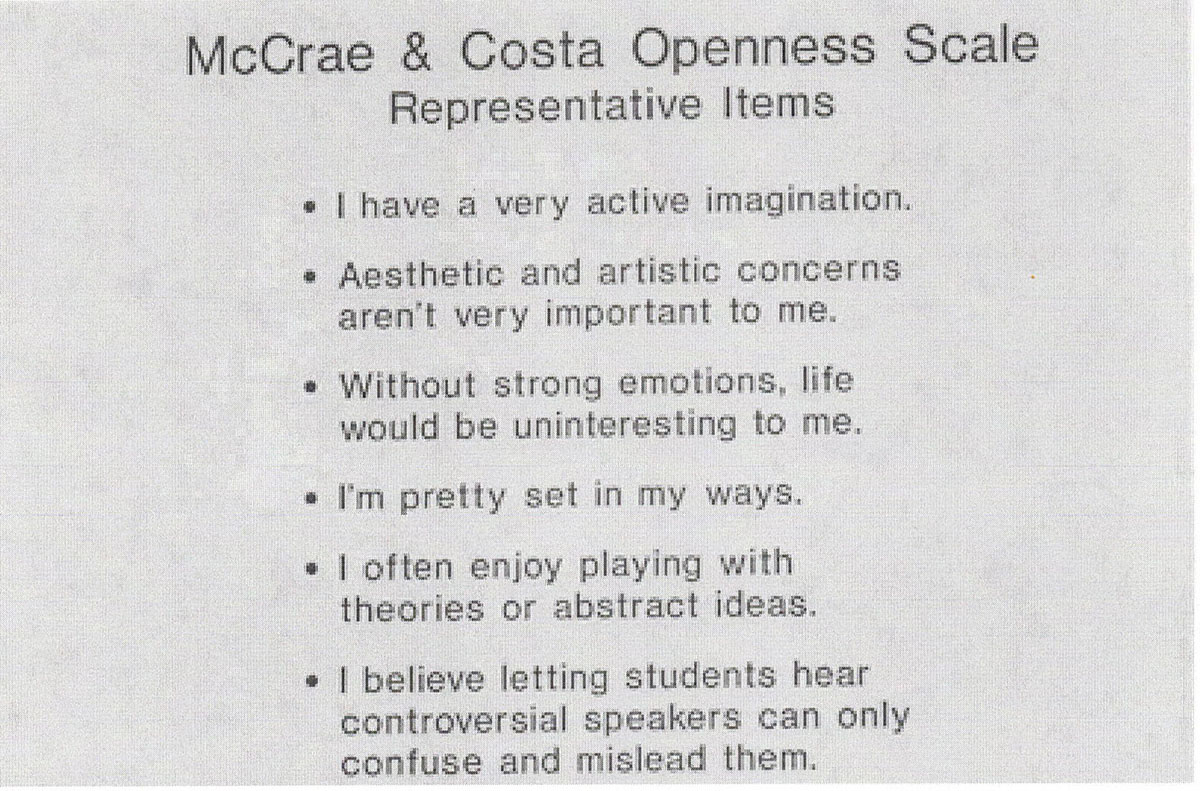 and Costa (1976) drew on
Coan's and Tellegen's work. Performing
another reanalysis of the 16PF, they uncovered
two fundamental factors -- extraversion and
neuroticism -- and a third, more heterogeneous
cluster of items relating to brightness,
tender-mindedness, imaginativeness,
and liberal thinking. They gathered
these items, and some new ones, into a
proposed major dimension of openness to
experience -- hence their NEO
Personality Inventory (NEO-PI), subsequently
expanded to include agreeableness and
conscientiousness as well.
Like the other constructs,
openness is defined in terms of 6 facets:
fantasy, sensitivity, self-awareness, need for
variety, curiosity, and liberalism. The
introduction of the NEO_PI solidified the construal of
Factor V as "openness".
and Costa (1976) drew on
Coan's and Tellegen's work. Performing
another reanalysis of the 16PF, they uncovered
two fundamental factors -- extraversion and
neuroticism -- and a third, more heterogeneous
cluster of items relating to brightness,
tender-mindedness, imaginativeness,
and liberal thinking. They gathered
these items, and some new ones, into a
proposed major dimension of openness to
experience -- hence their NEO
Personality Inventory (NEO-PI), subsequently
expanded to include agreeableness and
conscientiousness as well.
Like the other constructs,
openness is defined in terms of 6 facets:
fantasy, sensitivity, self-awareness, need for
variety, curiosity, and liberalism. The
introduction of the NEO_PI solidified the construal of
Factor V as "openness".
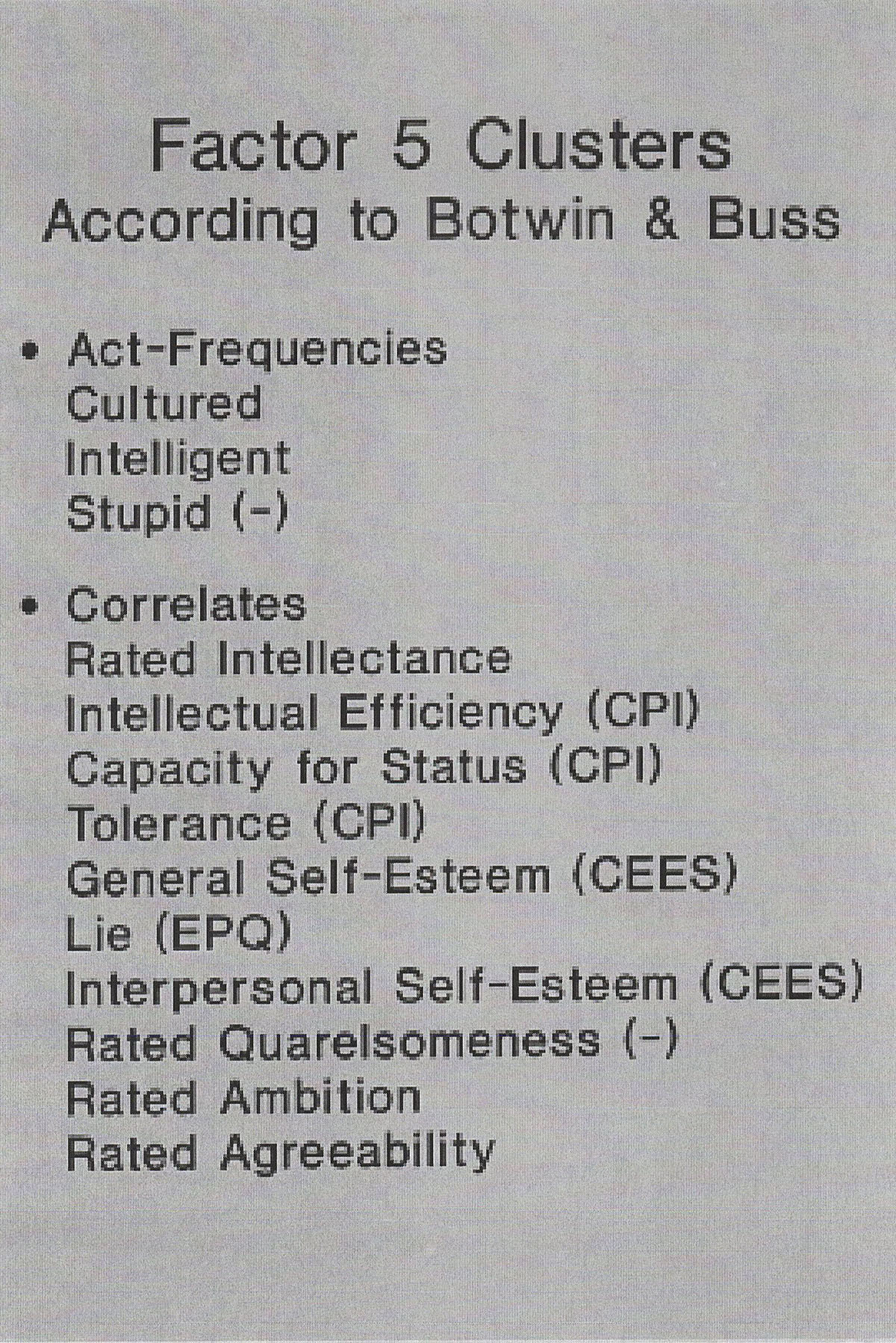 The
The 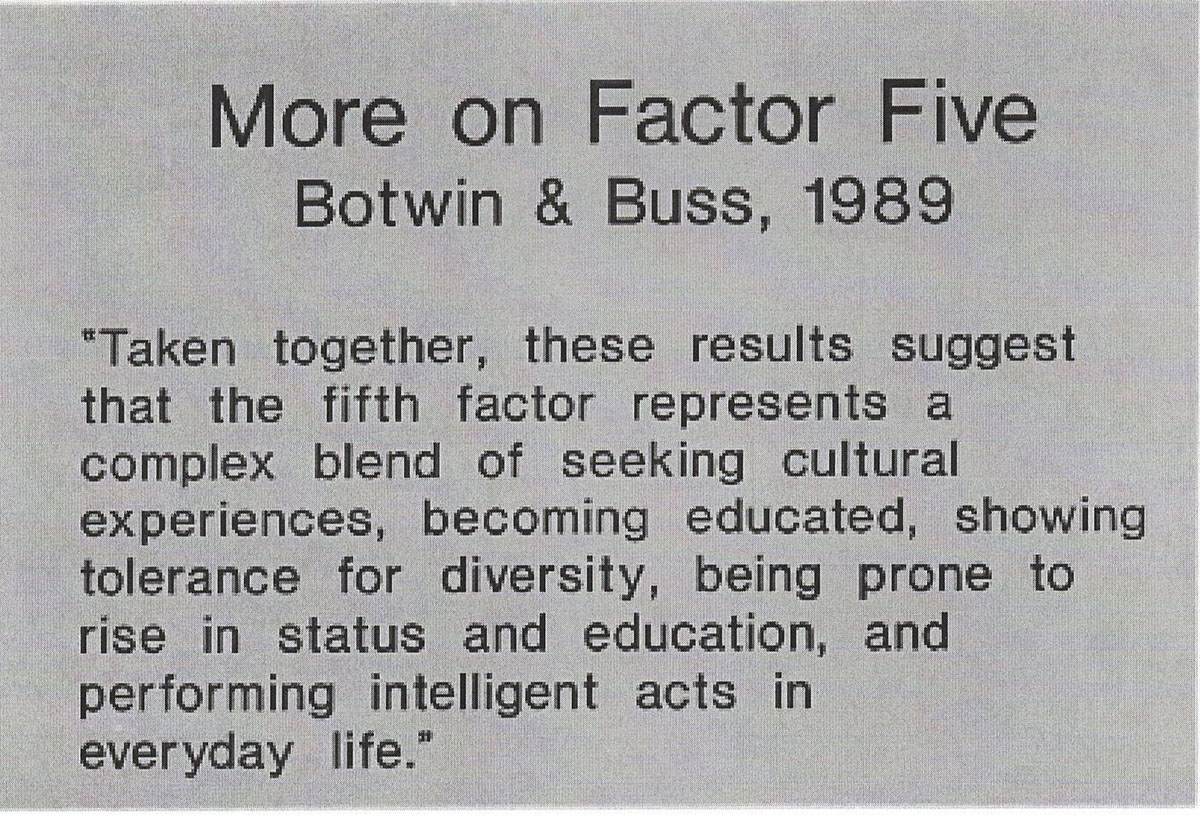 next chapter in this
story was a study by Botwin and Buss
(1989), who had 118 subjects make
"act-frequency" reports on 22 dimensions
derived from the Big Five, along
with supplementary trait ratings from 6
other data sources including Goldberg's
adjectives, self-ratings on Wiggins's
Interpersonal Adjective Scales, the EPQ,
CPU, and the California Self-Evaluation
Scale. Factor analysis
generally yielded five factors. Four
of these were the usual suspects --
extraversion, neuroticism,
agreeableness, and conscientiousness;
the fifth being a "complex blend" of
openness, culturedness and
intellectance.
next chapter in this
story was a study by Botwin and Buss
(1989), who had 118 subjects make
"act-frequency" reports on 22 dimensions
derived from the Big Five, along
with supplementary trait ratings from 6
other data sources including Goldberg's
adjectives, self-ratings on Wiggins's
Interpersonal Adjective Scales, the EPQ,
CPU, and the California Self-Evaluation
Scale. Factor analysis
generally yielded five factors. Four
of these were the usual suspects --
extraversion, neuroticism,
agreeableness, and conscientiousness;
the fifth being a "complex blend" of
openness, culturedness and
intellectance.
So it now appears
that absorption is related to openness, and by extension
hypnotizability is too. This makes sense, if we
remember the title of the original Tellegen & Atkinson
(1974) paper: "Openness to Absorbing and Self-Altering
Experiences... (emphasis
added)". But the issue proves to be still
more complicated, because B&B may have been too generous.
Factor V may
not be merely a "complex blend" of traits. It
may, in fact, be a hotchpot -- that is, a
collection of attributes that are in fact unrelated
to each other.
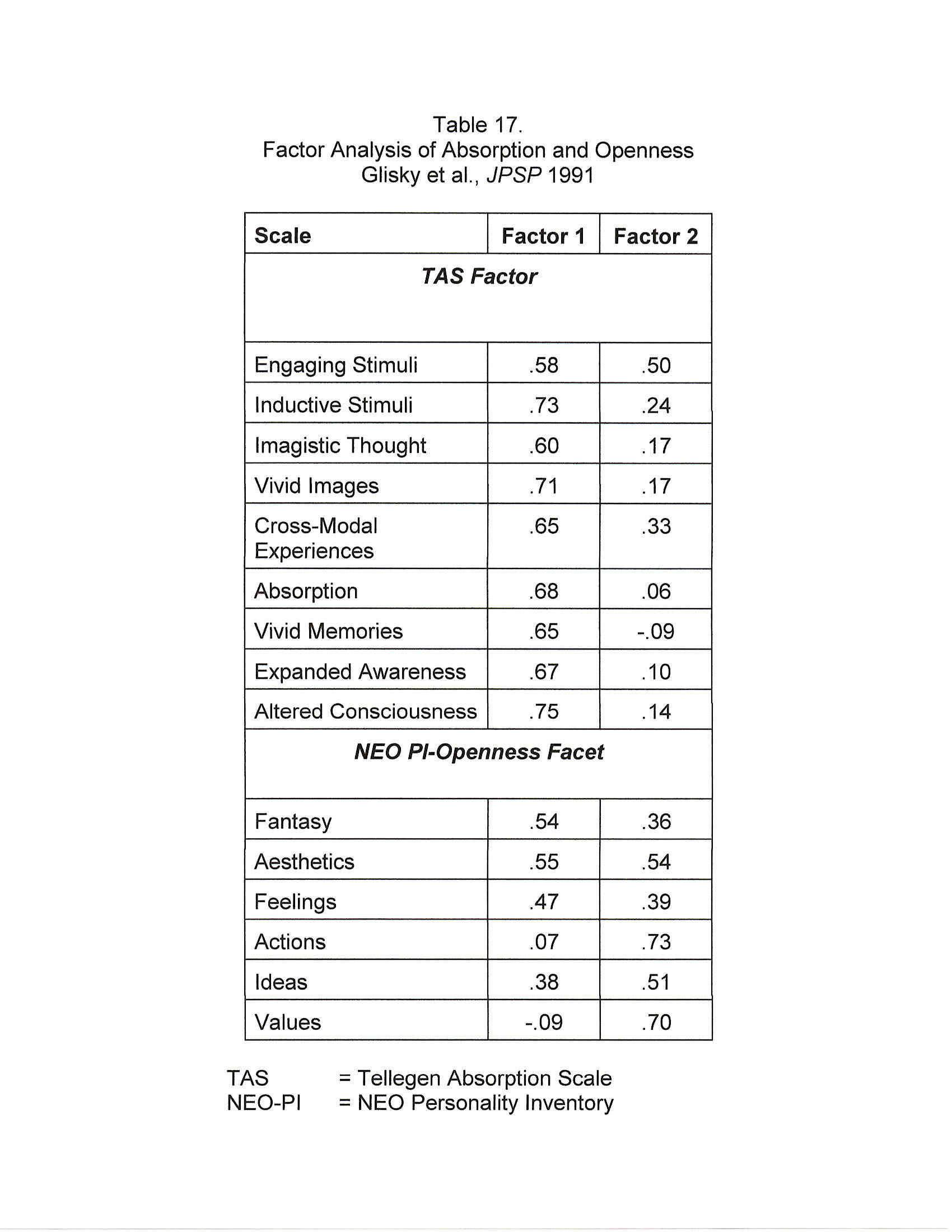 I
I 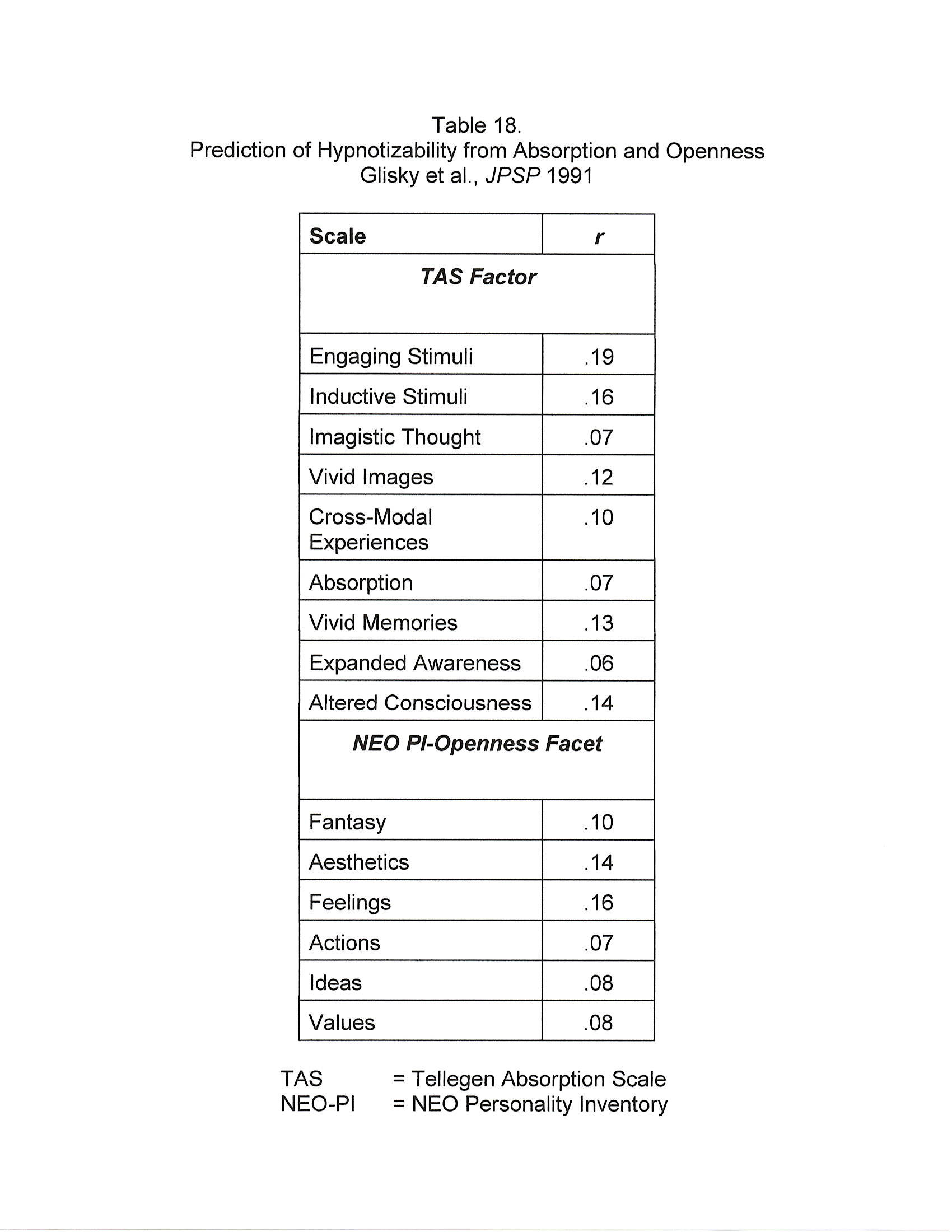 think that hypnosis can play a
role in addressing
this issue. I begin by looking at the
relationship between absorption and openness, as
reflected in a series of studies by Martha Glisky et al.
(1991). We had two samples, totaling
1,170 subjects, who completed a battery of
personality questionnaires including the TAS,
the CEI, and the Openness scale of the
NEO-PI. All the items were put into a
common response format and intermixed.
The total scale scores were all highly
intercorrelated, with individual rs
ranging from .71 to .85, and averaging
r = .78. The CEI proved strongly
redundant
with NEO-O, and so we eliminated it from
further analysis. We then did an
exploratory factor analysis. This was
not an item-level analysis, however.
Rather, we entered scores on subscales derived from
Tellegen's factor analysis of TAS and
McCosta's facets of NEO-Openness. The
two samples, separately and together,
yielded two factors:
think that hypnosis can play a
role in addressing
this issue. I begin by looking at the
relationship between absorption and openness, as
reflected in a series of studies by Martha Glisky et al.
(1991). We had two samples, totaling
1,170 subjects, who completed a battery of
personality questionnaires including the TAS,
the CEI, and the Openness scale of the
NEO-PI. All the items were put into a
common response format and intermixed.
The total scale scores were all highly
intercorrelated, with individual rs
ranging from .71 to .85, and averaging
r = .78. The CEI proved strongly
redundant
with NEO-O, and so we eliminated it from
further analysis. We then did an
exploratory factor analysis. This was
not an item-level analysis, however.
Rather, we entered scores on subscales derived from
Tellegen's factor analysis of TAS and
McCosta's facets of NEO-Openness. The
two samples, separately and together,
yielded two factors:
A subset of 550 subjects also completed an assessment of hypnotizability. The correlations with hypnotizability were consistently higher for absorption than for liberalism. A multiple regression analysis, predicting hypnotizability, yielded an R = .19 for the absorption factor, significantly higher than the R=10 for the liberalism factor. And within the NEO-O scale, the absorption facets correlated significantly higher than the liberalism facets.
This analysis indicates that openness, as measured by NEO-O, is factorially complex. It can be decomposed into two factors, absorption and liberalism. This in itself isn't particularly surprising. Any superordinate dimension of personality is going to be complex. But it turns out that absorption and liberalism are not very closely related at all. Furthermore, hypnotizability show a pattern of differential correlations, with absorption, but not with liberalism. This suggests to us that absorption and liberalism don't really belong together in the first place.
Our suspicions are strengthened by Tellegen's findings with this Multidimensional Personality Questionnaire, in which separate scales measuring absorption and traditionalism (the reflection of liberalism) are essentially uncorrelated.
All of this has led to a series of studies focused on exploring the heterogeneity Factor V.
The work began with
a collaboration with Paul Trapnell, a student of Jerry Wiggins's at UBC,
who is now a professor at the University of Manitoba
(Personal Communication, April 18, 1990 et seq.).
Trapnell had performed a reanalysis of Goldberg's 1710
data, which remains the most comprehensive set of adjective
self-ratings available. Recall, that this data
set, collected in 1973, consists of self-ratings by 186 subjects on
a 1-8 scale. Trapnell rationally constructed
his item set so that it consisted of 52 4-item
clusters representing the Big Five, including 14
clusters representing Factor V, plus 5 additional
clusters comprising additional Factor V adjectives.
From now on, I'll call these Trapnell
clusters. Thus, Trapnell's item set
represents many different facets of Factor V.
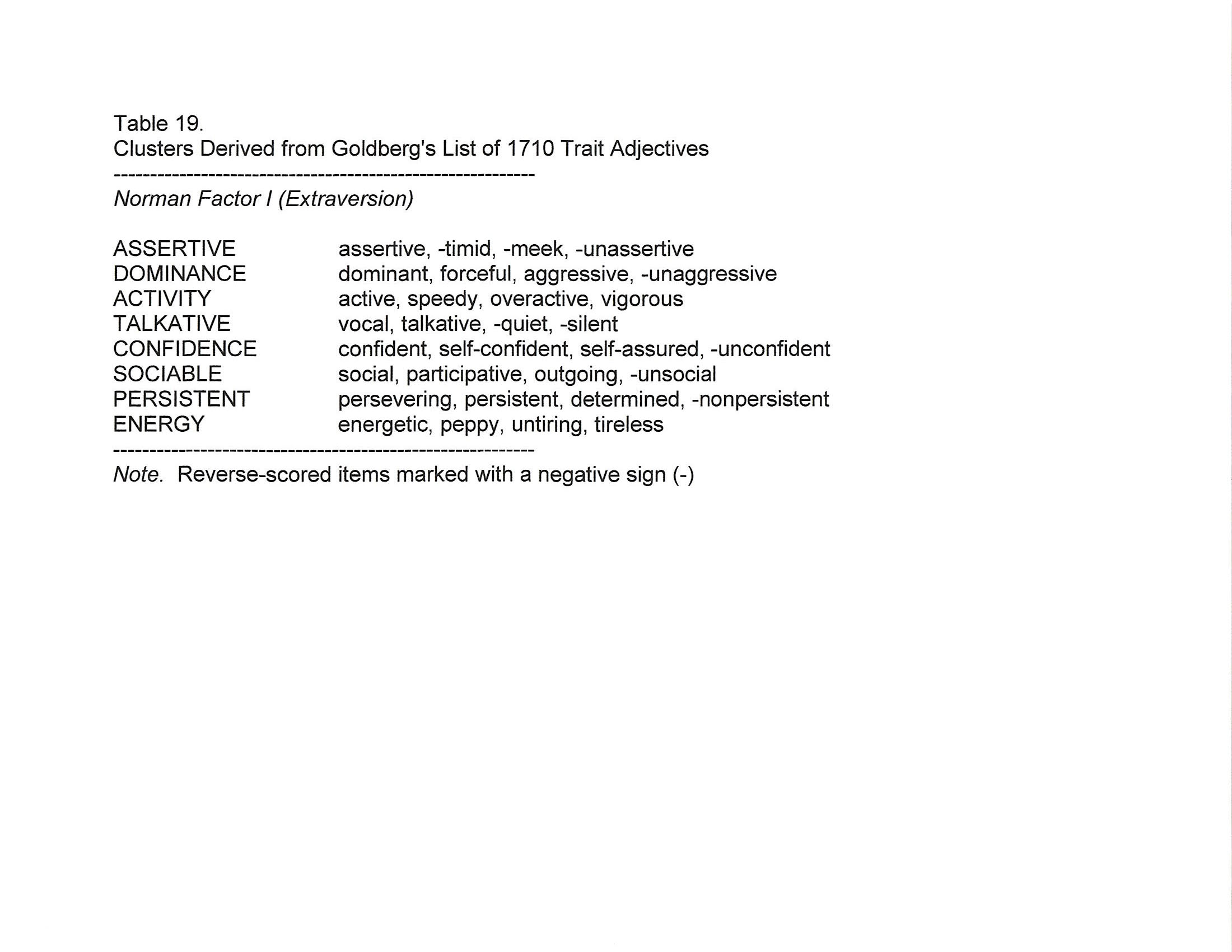 |
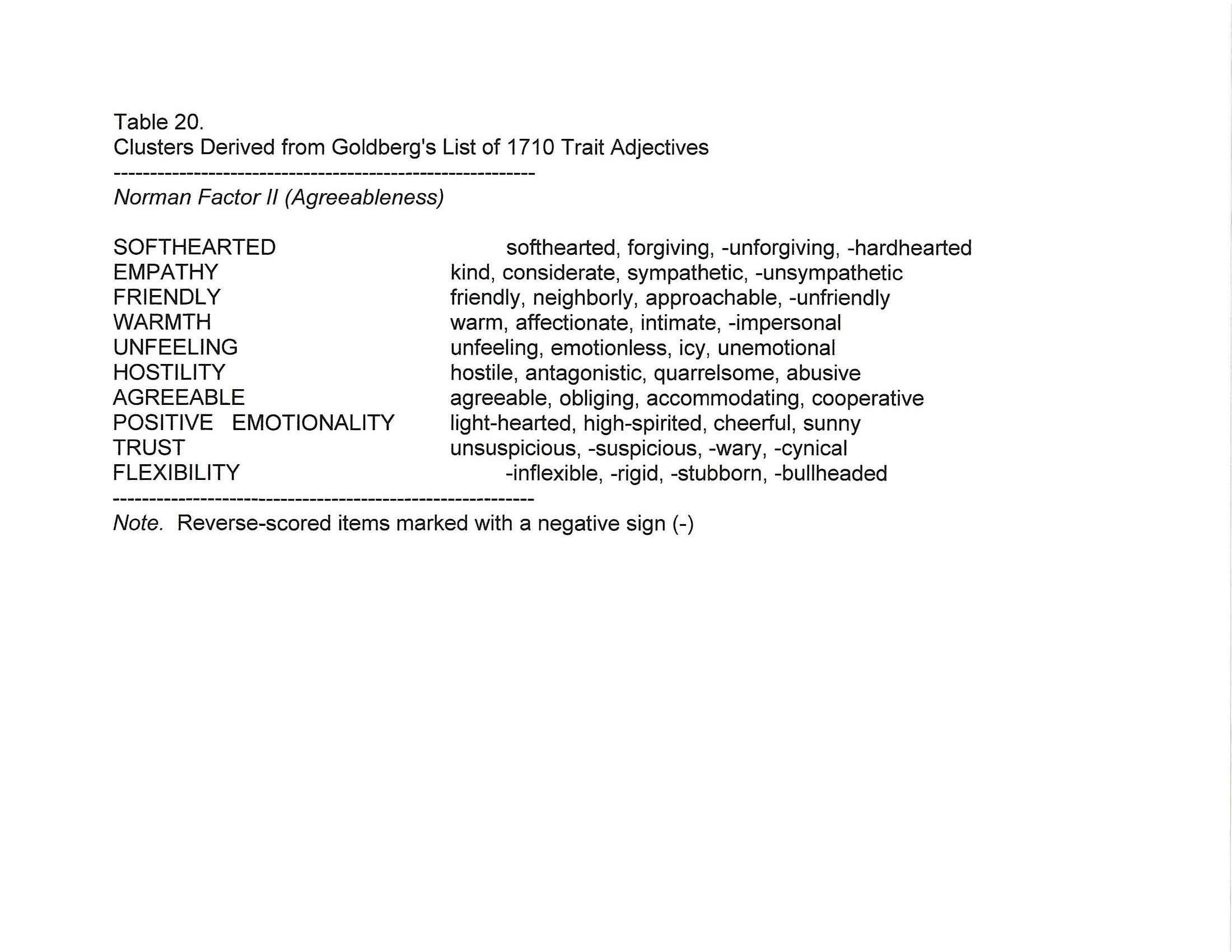 |
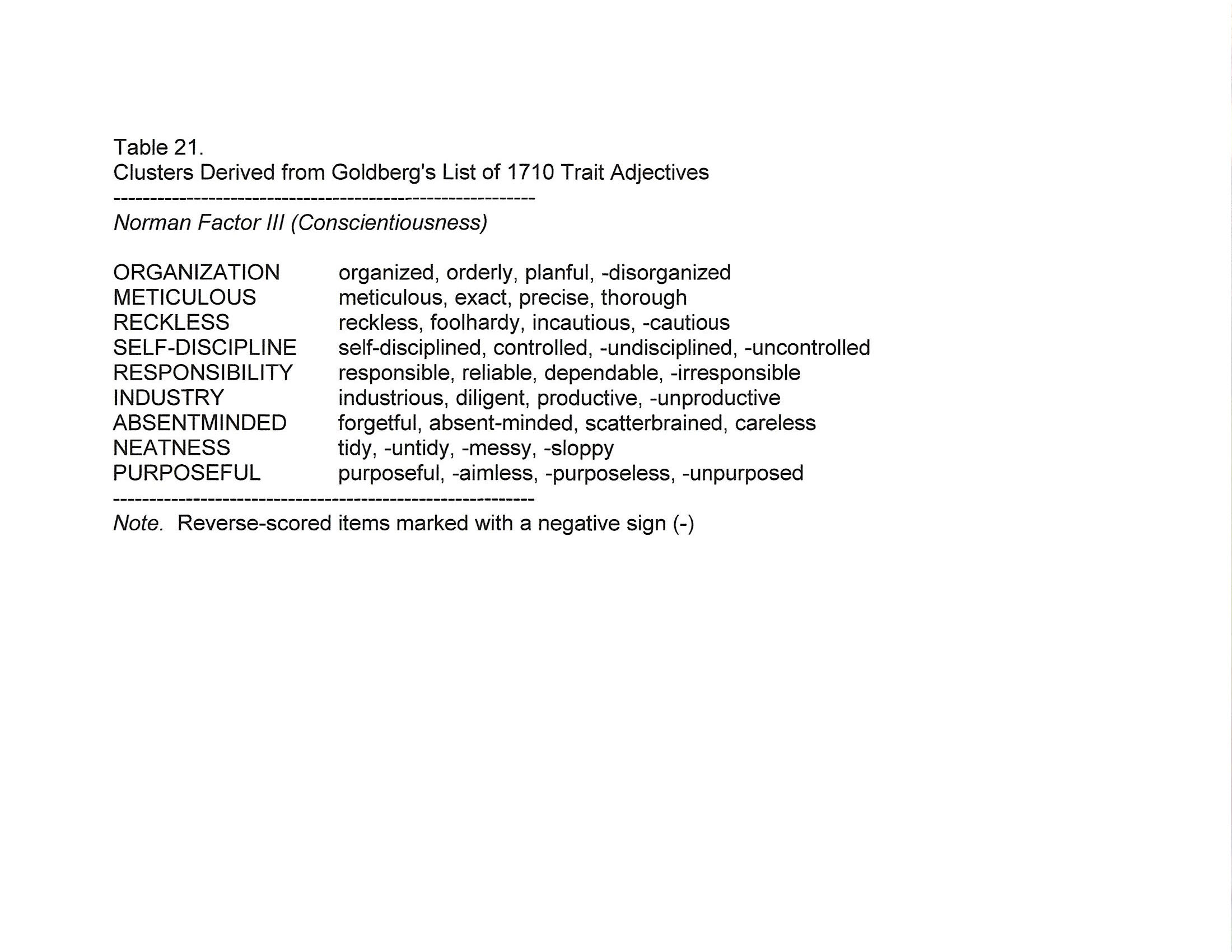 |
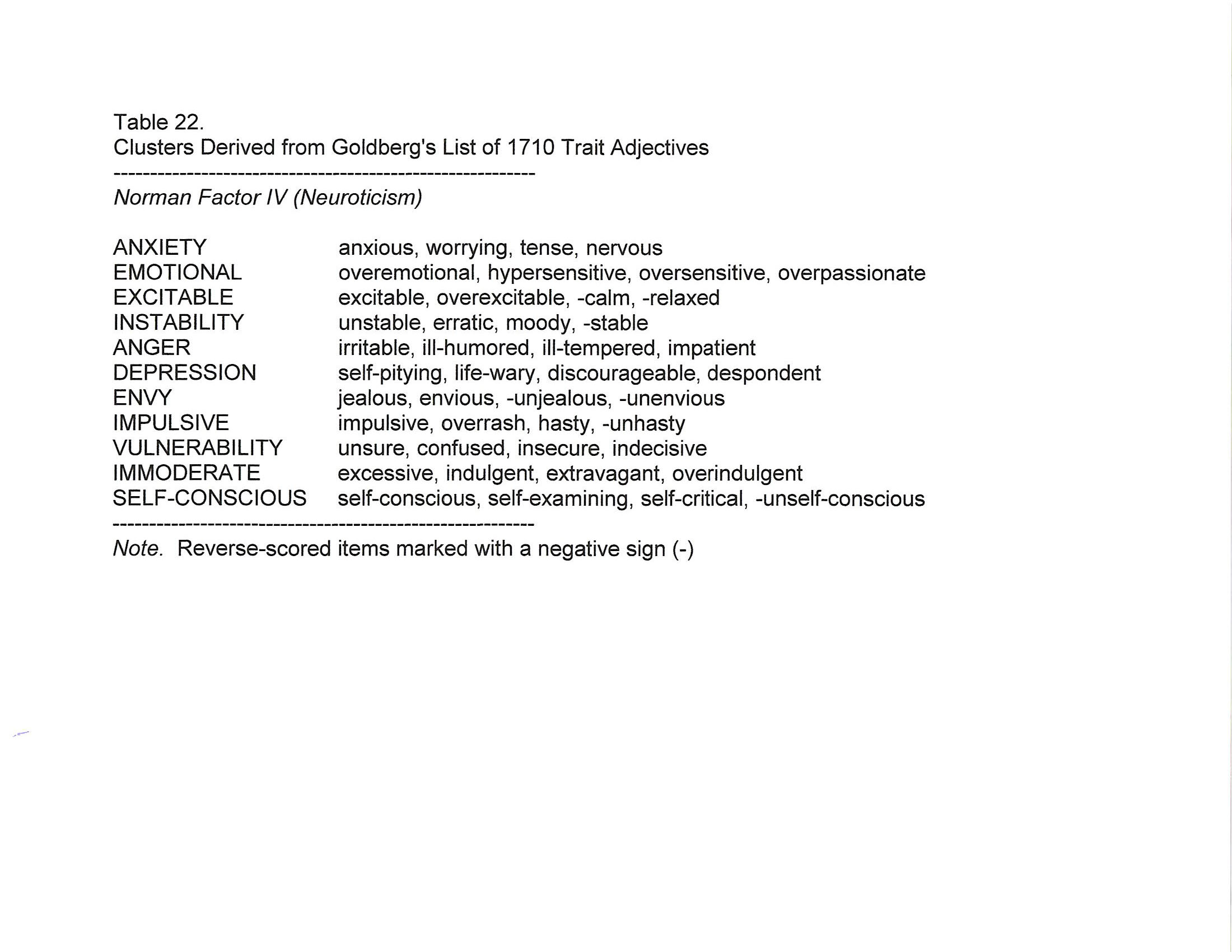 |
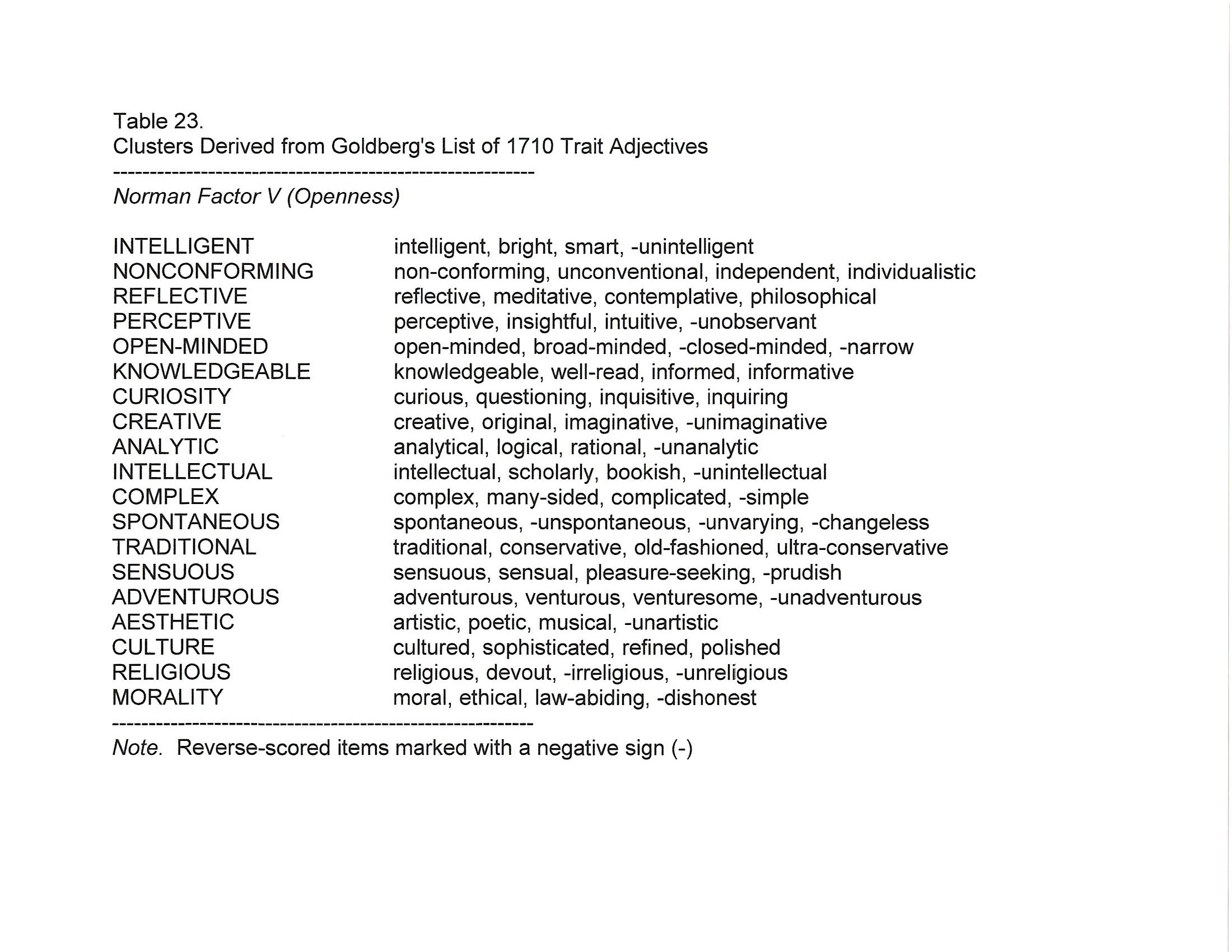 |
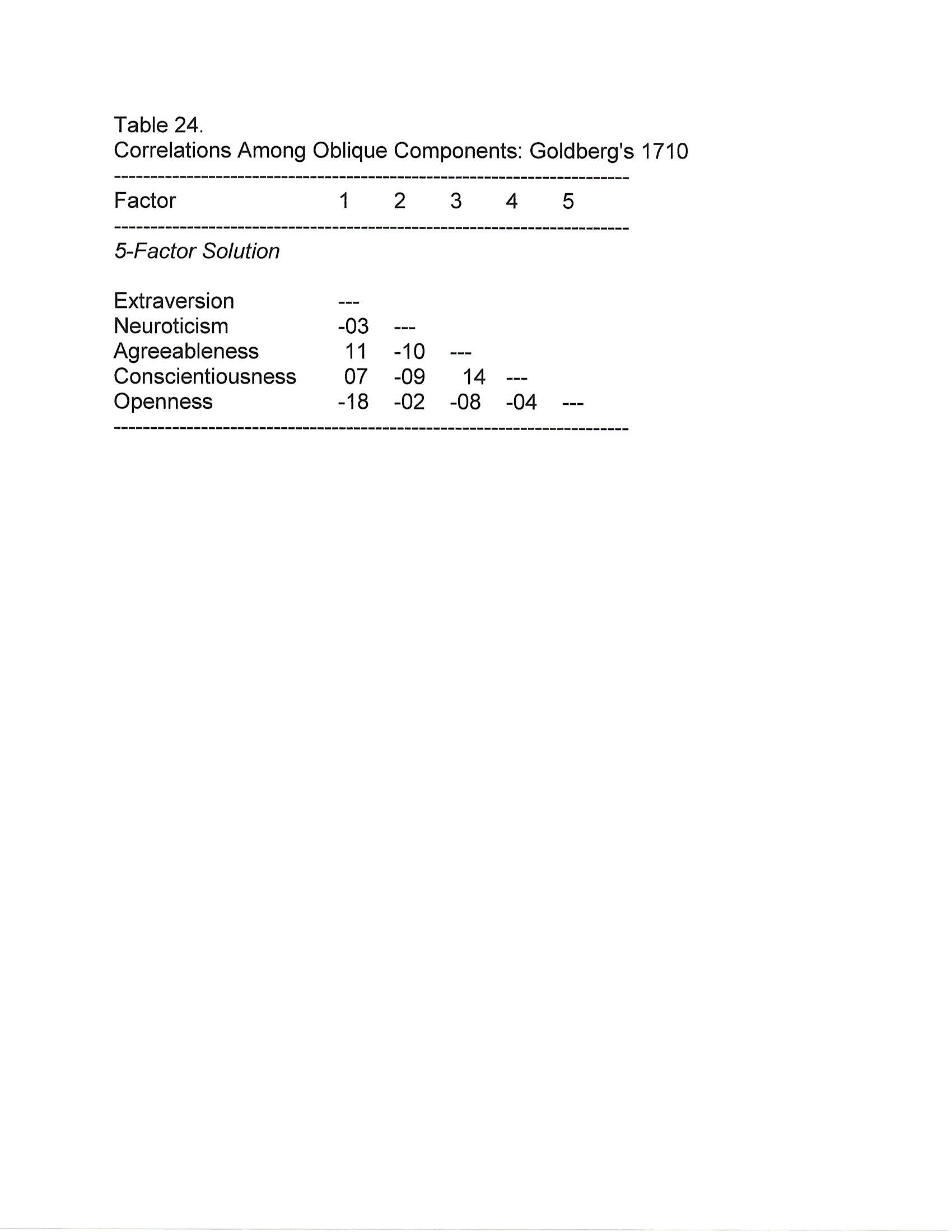 He
then performed an exploratory principal-components analysis,
with oblique rotation, because he wanted to be able to see how the various components
actually related to each other. Extracting 5 factors
yielded a good replica
of the Big Five solution, with the clusters lining up just the way they're
supposed to. The dimensions were also fairly
independent of each other, with rs ranging from
-.18 to .14. In particular, Factor V was
independent of the other four, with a mean |r| = .08.
He
then performed an exploratory principal-components analysis,
with oblique rotation, because he wanted to be able to see how the various components
actually related to each other. Extracting 5 factors
yielded a good replica
of the Big Five solution, with the clusters lining up just the way they're
supposed to. The dimensions were also fairly
independent of each other, with rs ranging from
-.18 to .14. In particular, Factor V was
independent of the other four, with a mean |r| = .08.
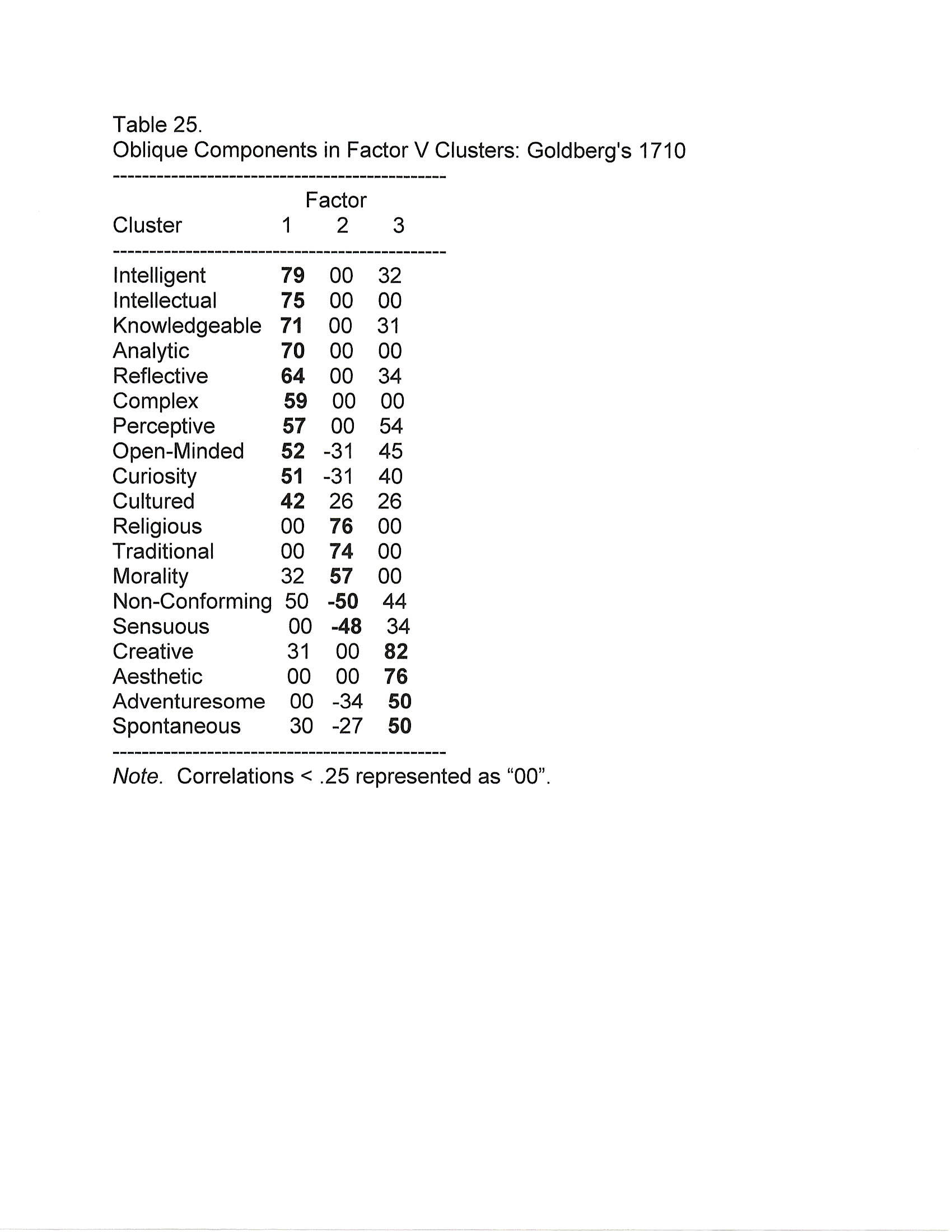 But
a separate EFA of the 19 Factor V clusters yielded 3
factors -- intellectance, traditionalism, and
openness. Interestingly, the intercorrelations
among these oblique components were all fairly low,
ranging from r = -.15 to .33.
But
a separate EFA of the 19 Factor V clusters yielded 3
factors -- intellectance, traditionalism, and
openness. Interestingly, the intercorrelations
among these oblique components were all fairly low,
ranging from r = -.15 to .33.
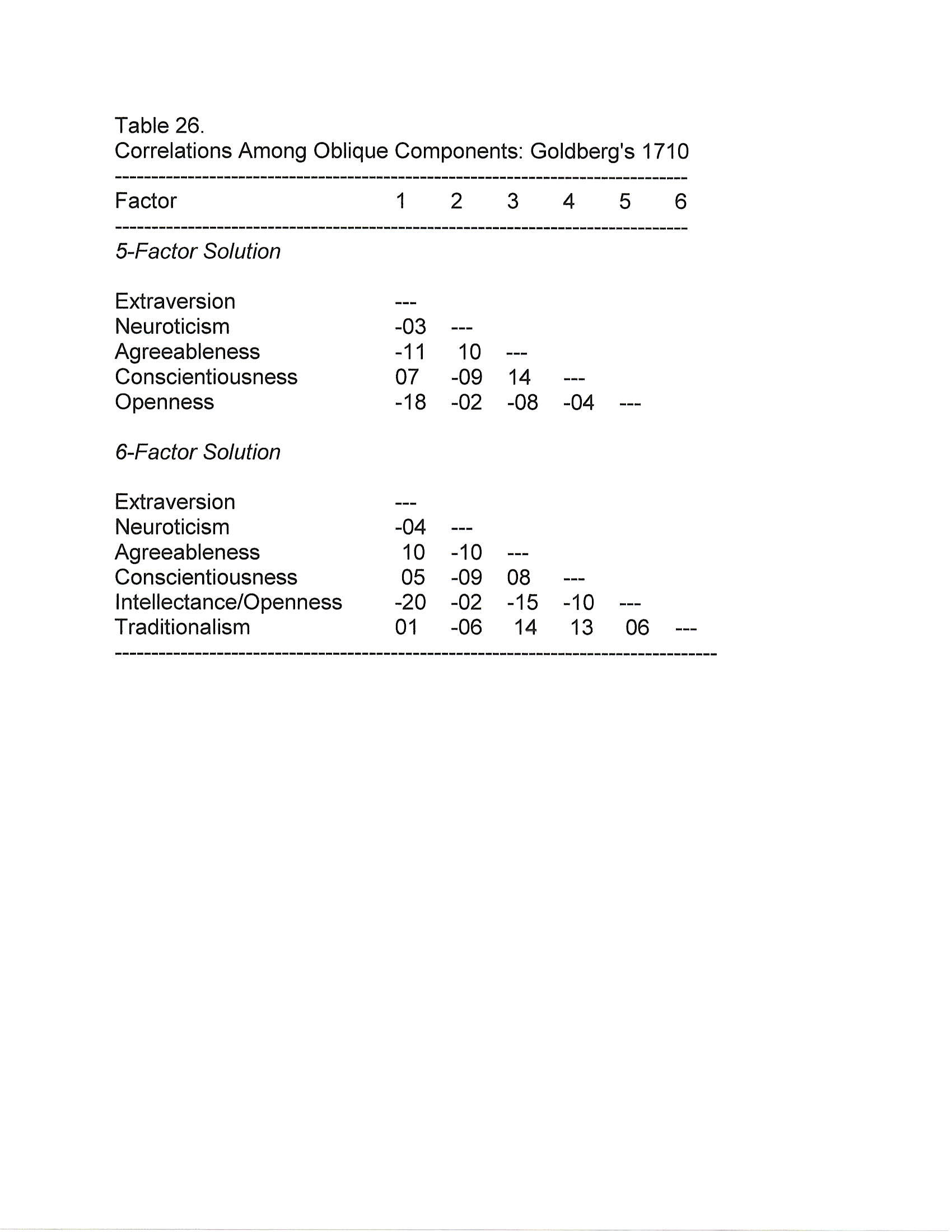 Returning
Returning 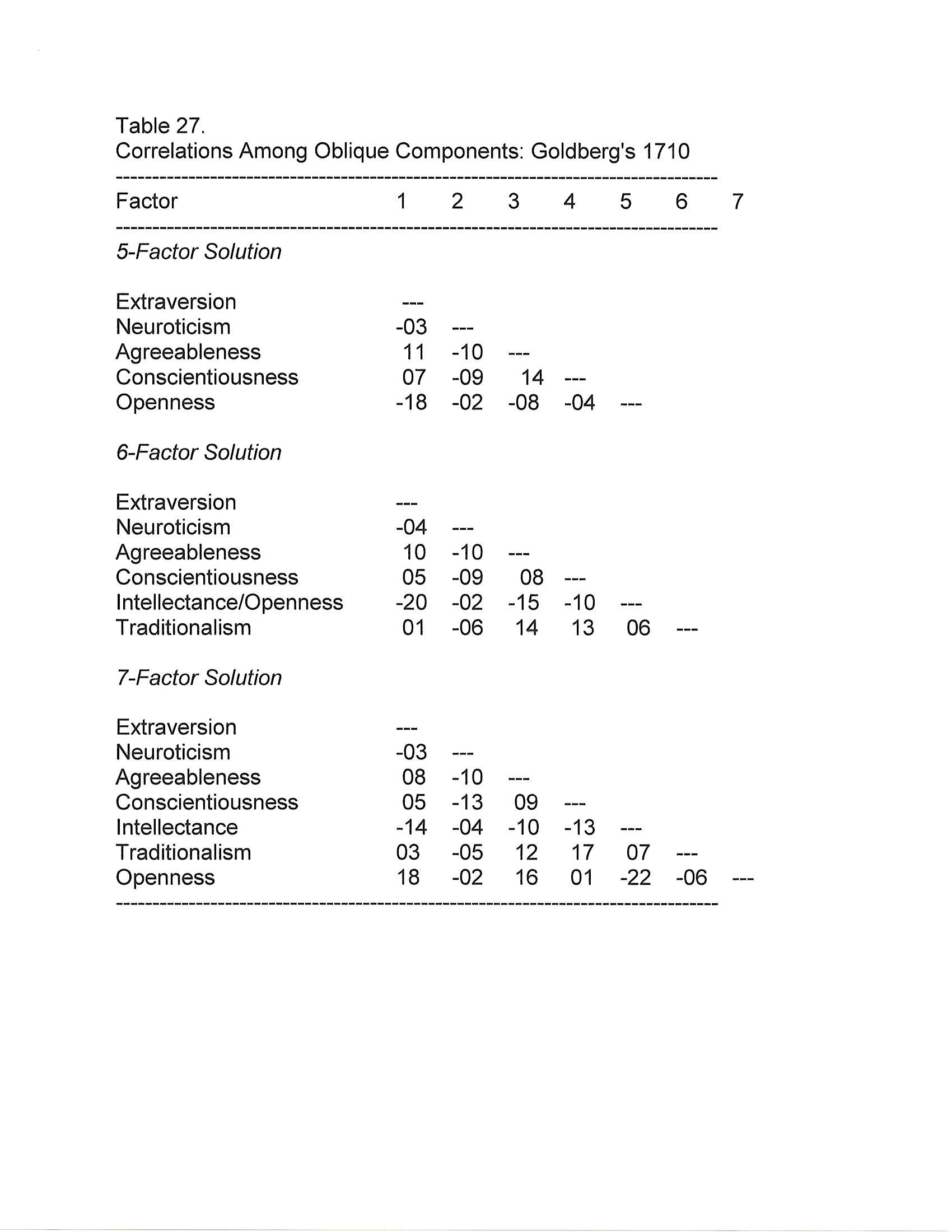 to
the data set as a whole, EFA yielded 10 factors.
Extracting just 6 factors, traditionalism split off from
intellectance and openness. Both factors were
independent of the
remaining 4, with mean |rs|
= .09 and .12, respectively. And, more
important, the two Factor V subfactors were independent of
each other, r = .06. Extracting 7
factors, openness split off from
intellectance. All of three subfactors were fairly
independent of the other 4, with mean |r| = .11, .09,
and .09, respectively. And, again,
these subfactors were independent of each
other, with mean |r| = .06.
to
the data set as a whole, EFA yielded 10 factors.
Extracting just 6 factors, traditionalism split off from
intellectance and openness. Both factors were
independent of the
remaining 4, with mean |rs|
= .09 and .12, respectively. And, more
important, the two Factor V subfactors were independent of
each other, r = .06. Extracting 7
factors, openness split off from
intellectance. All of three subfactors were fairly
independent of the other 4, with mean |r| = .11, .09,
and .09, respectively. And, again,
these subfactors were independent of each
other, with mean |r| = .06.
I don't know happened with factors 8-10, but the analysis so far makes the important point: When the Big Five structure breaks up, Factor V breaks up first, and the various facets of Factor V are as independent of each other as they are from each of the remaining Big Five factors.
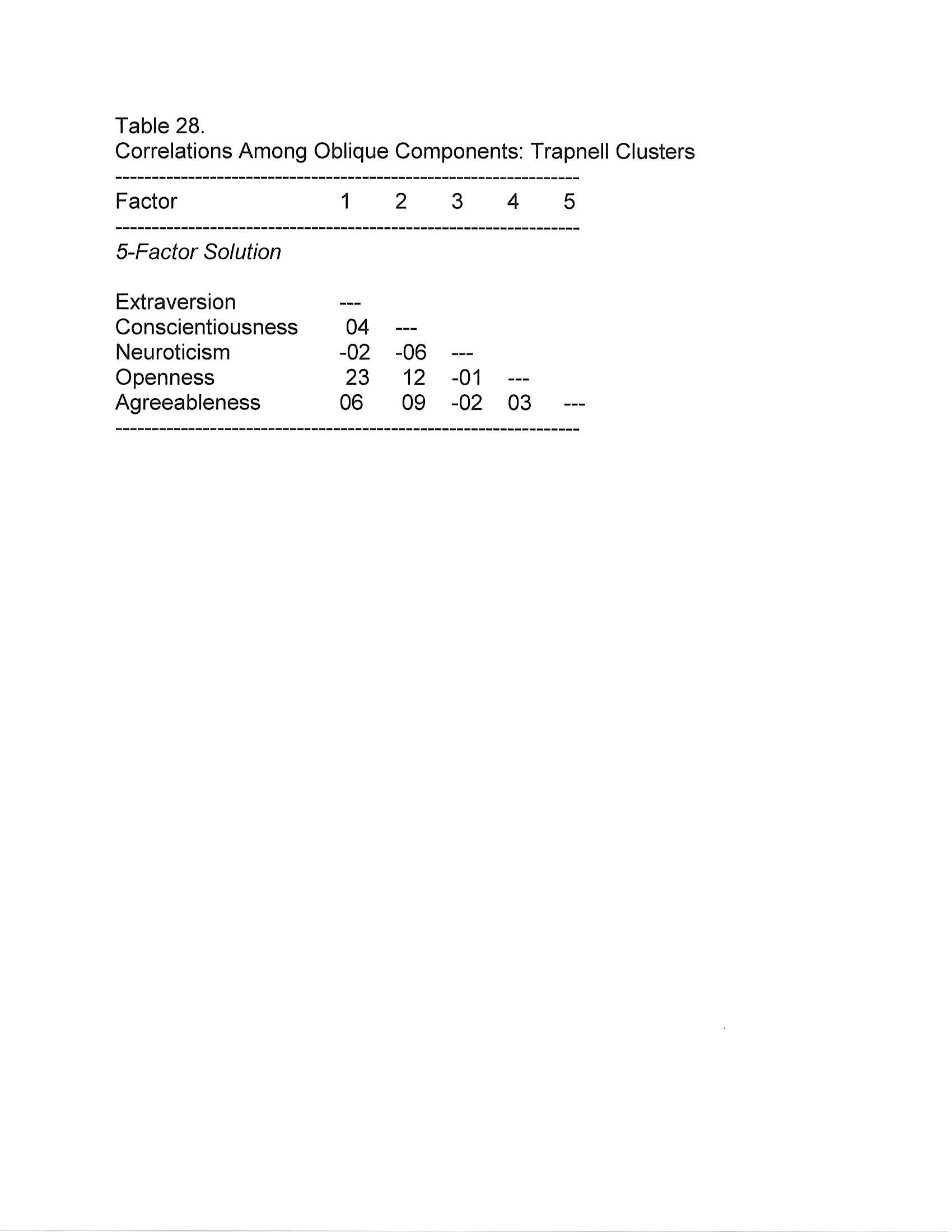 Of
course, we might expect the factor
structure to be a little unstable:
Trapnell was
analyzing 57 clusters in 187
subjects, which violates the 4:1
(or is it 40:1?) ratio
that's desirable for these kinds
of studies. So we repeated the
study at the University of
Arizona, where 1,402
students in the introductory
psychology course a
questionnaire based on the
Trapnell clusters (again,
rating the clusters on a 1-8
scale).. EFA with oblique
rotation yielded 9
factors.
Extracting the first 5
factors again yielded a good
replica of the Big Five
solution. The clusters
lined up just the way
they're supposed to, with
the exception that Factor V
emerged as the 4th, not the
5th, factor -- which we
attribute to
oversampling of "openness"
items.
The factors
were fairly
independent of
each other, with rs
ranging from -.02 to
.23. And
in particular,
openness was
independent of
the other 4,
with a mean |r|
= .05.
Of
course, we might expect the factor
structure to be a little unstable:
Trapnell was
analyzing 57 clusters in 187
subjects, which violates the 4:1
(or is it 40:1?) ratio
that's desirable for these kinds
of studies. So we repeated the
study at the University of
Arizona, where 1,402
students in the introductory
psychology course a
questionnaire based on the
Trapnell clusters (again,
rating the clusters on a 1-8
scale).. EFA with oblique
rotation yielded 9
factors.
Extracting the first 5
factors again yielded a good
replica of the Big Five
solution. The clusters
lined up just the way
they're supposed to, with
the exception that Factor V
emerged as the 4th, not the
5th, factor -- which we
attribute to
oversampling of "openness"
items.
The factors
were fairly
independent of
each other, with rs
ranging from -.02 to
.23. And
in particular,
openness was
independent of
the other 4,
with a mean |r|
= .05.
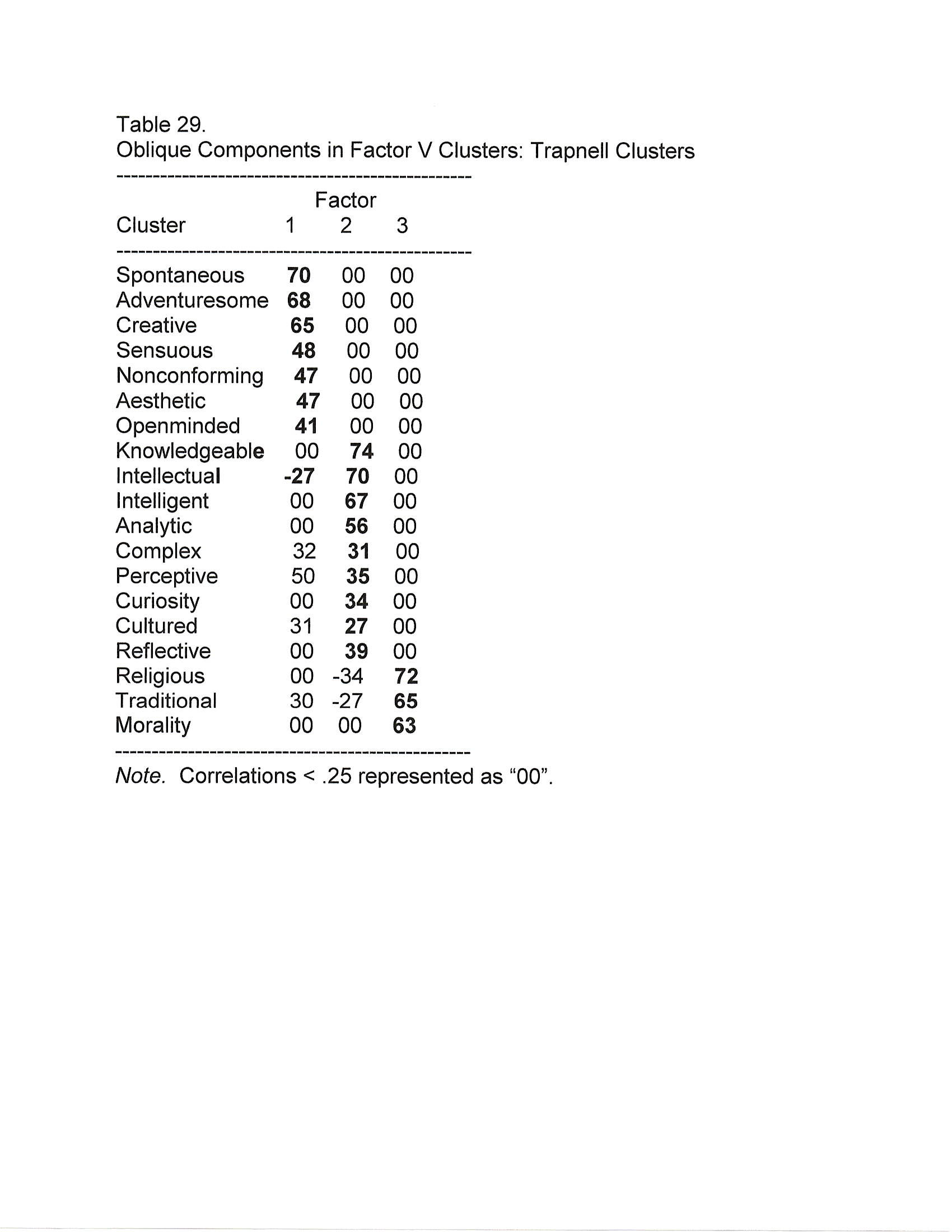 A
separate EFA
of the 19
Factor V
clusters
initially
yielded 5
factors.
When we
rotated just
the first 3,
we again got
intellectance,
traditionalism,
and
openness.
And again the
intercorrelations
among these
oblique
components
were all
fairly low,
with rs
ranging from
-.02 to .27.
A
separate EFA
of the 19
Factor V
clusters
initially
yielded 5
factors.
When we
rotated just
the first 3,
we again got
intellectance,
traditionalism,
and
openness.
And again the
intercorrelations
among these
oblique
components
were all
fairly low,
with rs
ranging from
-.02 to .27.
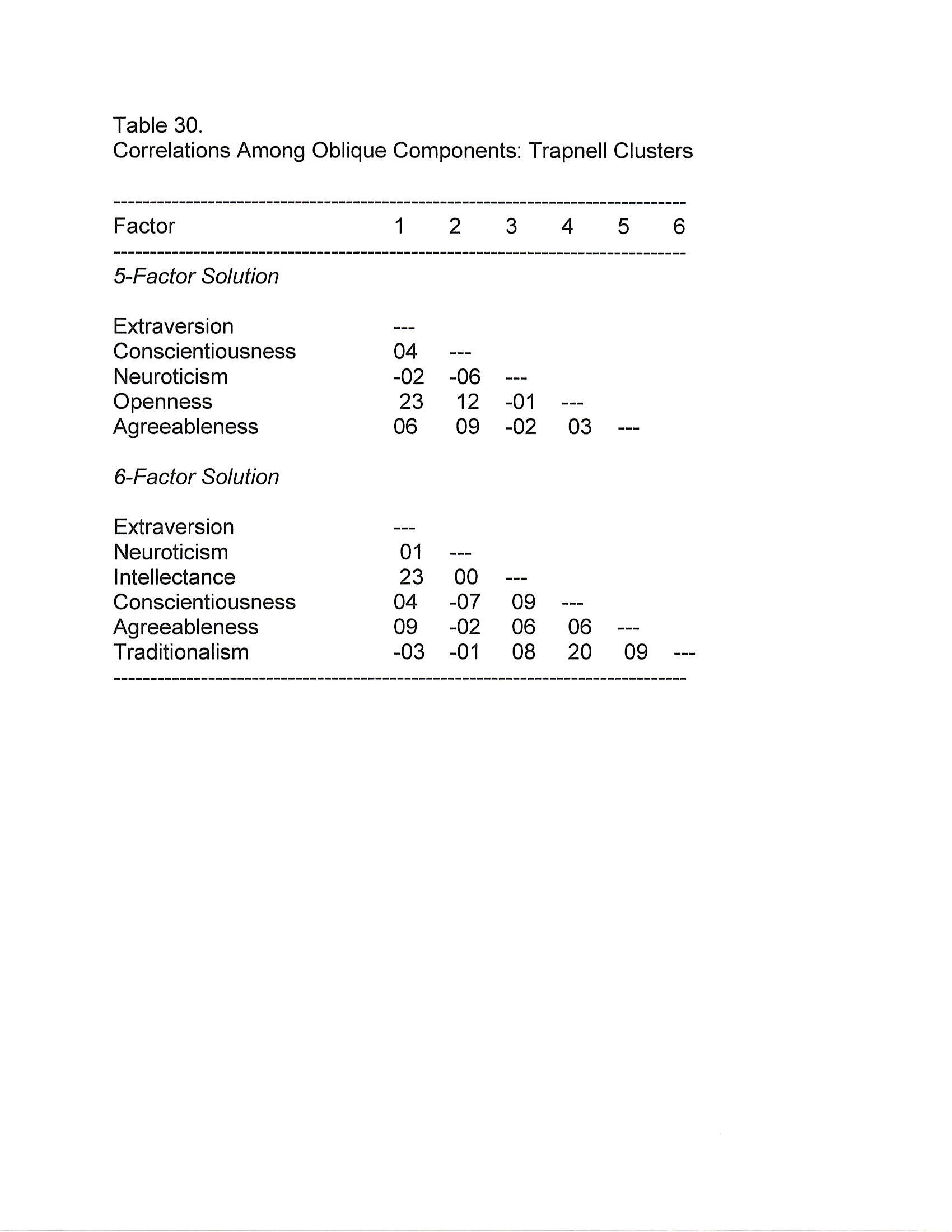 Returning
to the whole data set,
recall that the initial EFA actually yielded 9
factors. Extracting just 6 factors,
traditionalism split off from intellectance and
openness, just as it had done in Trapnell's original
analysis. Both factors were independent of the
other 4, with mean |r| = .08 and .08,
respectively. And the two factors were
independent of each other, r = .08.
Returning
to the whole data set,
recall that the initial EFA actually yielded 9
factors. Extracting just 6 factors,
traditionalism split off from intellectance and
openness, just as it had done in Trapnell's original
analysis. Both factors were independent of the
other 4, with mean |r| = .08 and .08,
respectively. And the two factors were
independent of each other, r = .08.
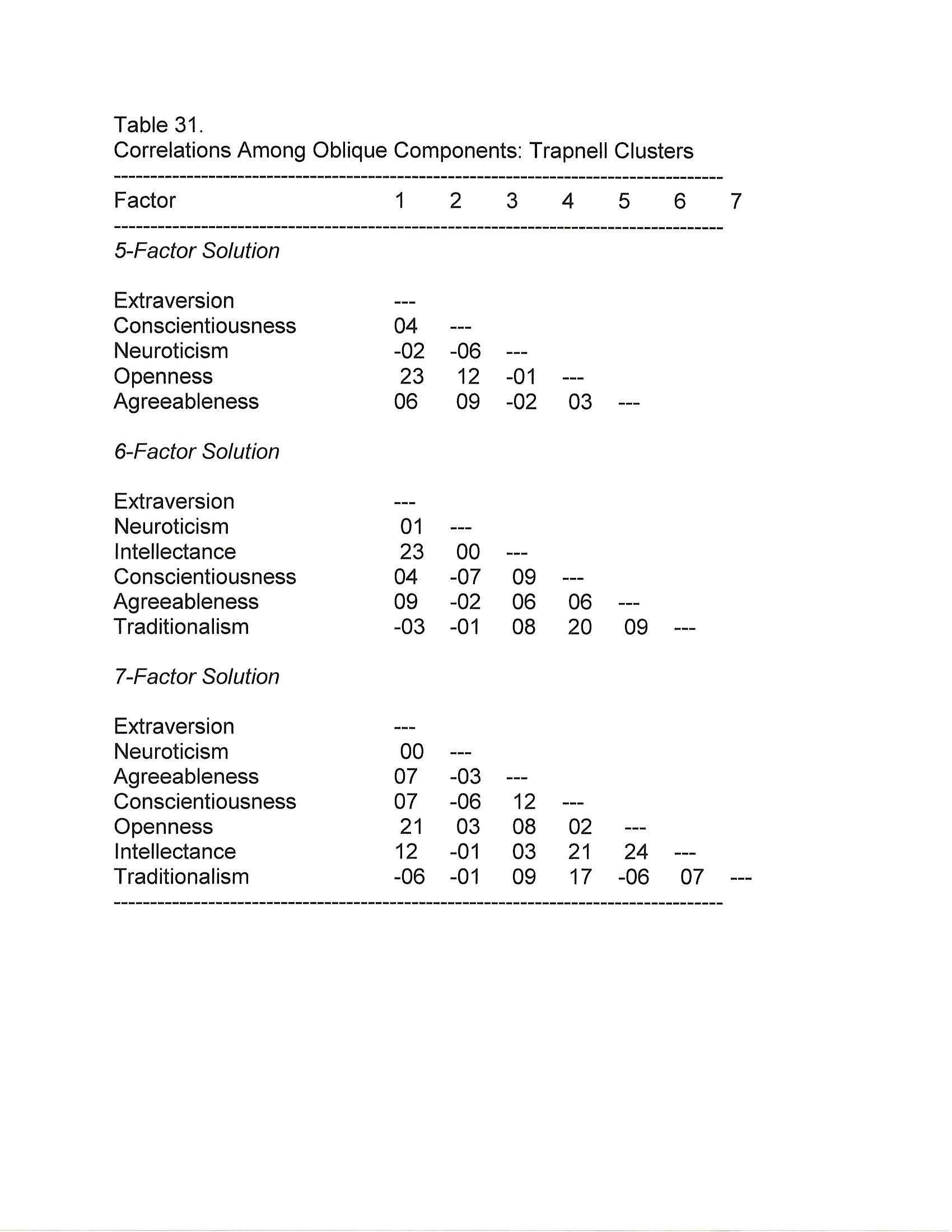 Extracting
7 factors, openness split off from intellectance.
All three openness factors were independent of the other
4, with mean |r| = .08, .09, and .08. And
each was independent
of the other two, with mean |r| = .12.
Extracting
7 factors, openness split off from intellectance.
All three openness factors were independent of the other
4, with mean |r| = .08, .09, and .08. And
each was independent
of the other two, with mean |r| = .12.
So again, when the Big Five structure breaks up, Factor V breaks up first, and the various facets of Factor V are as independent of each other as they are from each of the remaining Big Five factors.
We've now replicated these findings in a third study, involving 1,027 undergraduates who completed self-ratings based on the Trapnell clusters.
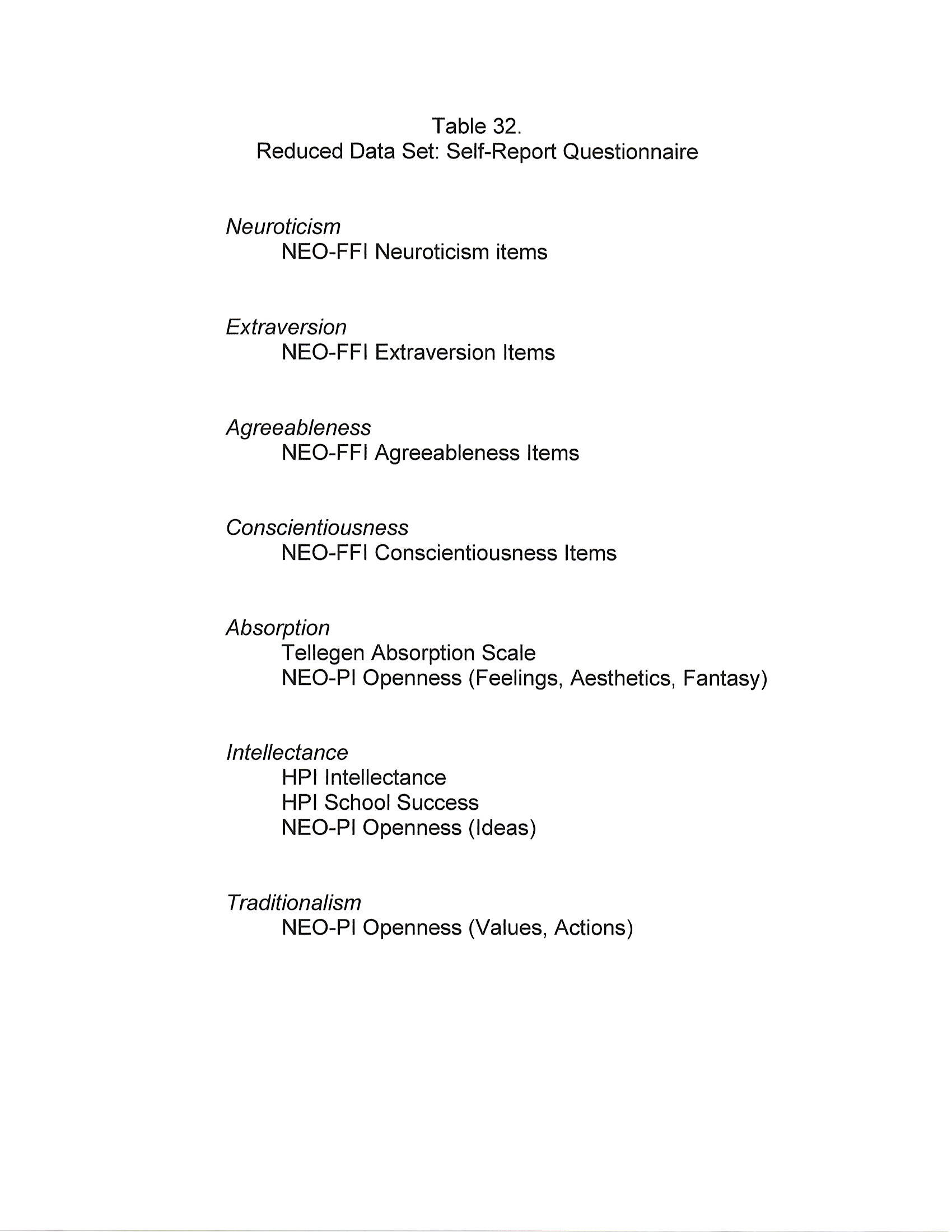 In
addition, we've moved beyond the "personality
sphere" of trait adjectives. To this end, a
subset of 855 subjects from the third study also completed a
170-item self-report questionnaire containing:
In
addition, we've moved beyond the "personality
sphere" of trait adjectives. To this end, a
subset of 855 subjects from the third study also completed a
170-item self-report questionnaire containing:
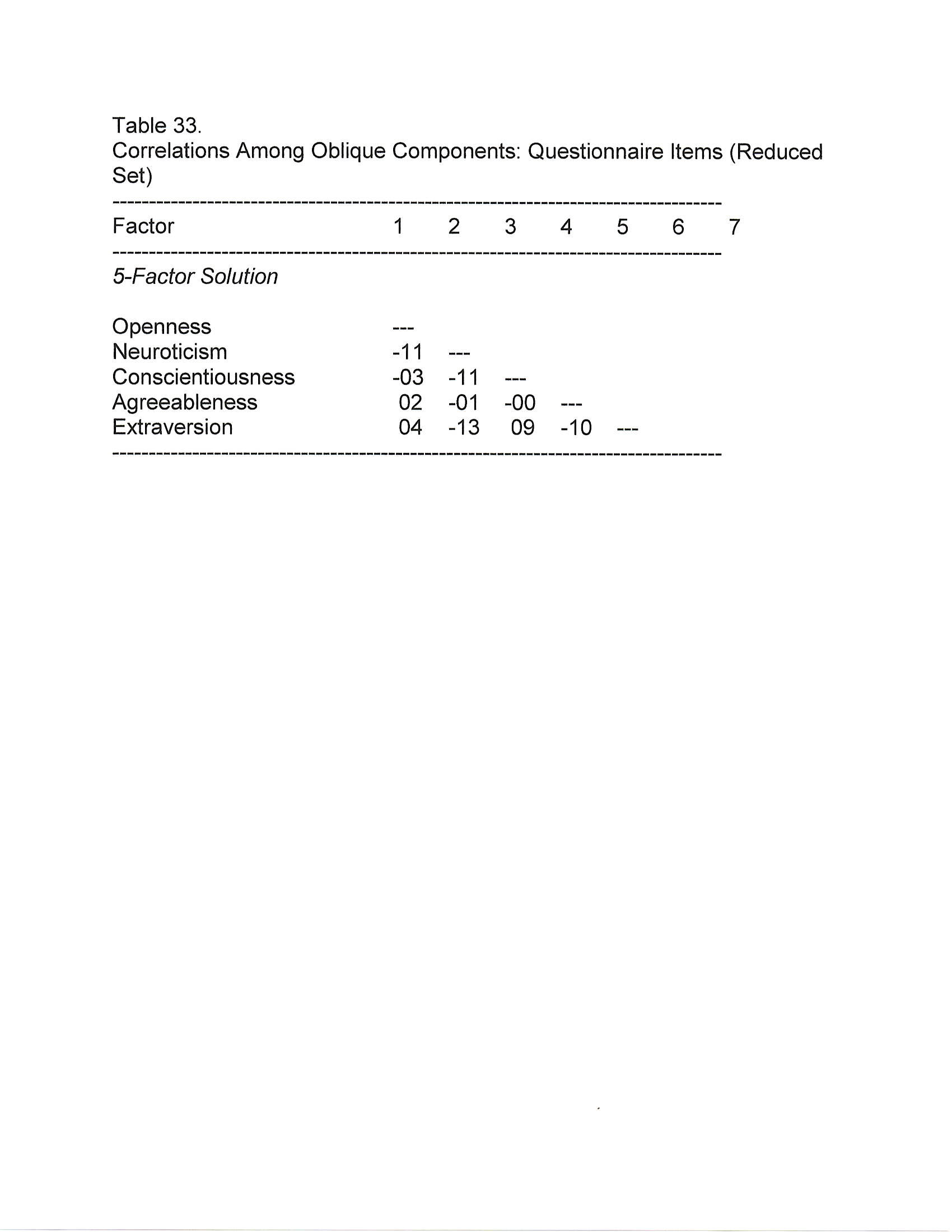 EFA
of these 84 items yielded 18 factors.
Extracting the first 5 factors again yielded a good
replica of the Big Five solution. Again, probably
due to oversampling, Factor V emerged as the first
factor. These factors were fairly independent of
each other, with rs
ranging from -.13 to .09. And in particular,
openness was independent of the other 4, mean |r|
= .05.
EFA
of these 84 items yielded 18 factors.
Extracting the first 5 factors again yielded a good
replica of the Big Five solution. Again, probably
due to oversampling, Factor V emerged as the first
factor. These factors were fairly independent of
each other, with rs
ranging from -.13 to .09. And in particular,
openness was independent of the other 4, mean |r|
= .05.
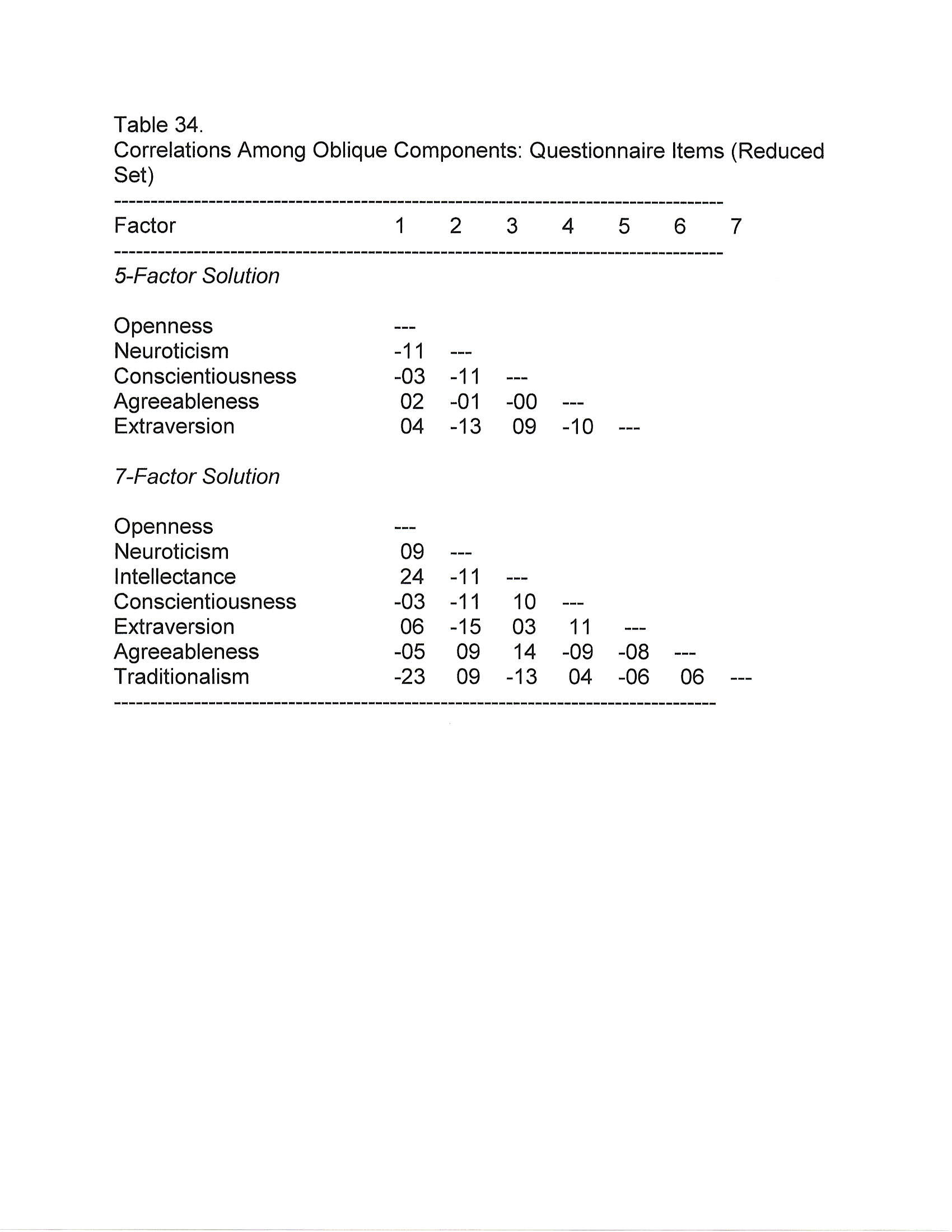 To
get right to the punch line, extracting 7 factors,
"Factor V" split up as expected, into separate absorption,
intellectance, and traditionalism factors. All
were fairly independent of Factors I-IV, with mean |r|
= .06, .12, and .06. And each was fairly
independent of the others, mean |r| = .20.
To
get right to the punch line, extracting 7 factors,
"Factor V" split up as expected, into separate absorption,
intellectance, and traditionalism factors. All
were fairly independent of Factors I-IV, with mean |r|
= .06, .12, and .06. And each was fairly
independent of the others, mean |r| = .20.
So again, when the Big Five structure breaks up, Factor V breaks up first, and the various facets of Factor V are as independent of each other as they are from each of the remaining Big Five factors -- or at least as much as the remaining Big Four factors are from each other. Put another way, the three construals of "Factor V" are relatively unrelated to each other. Each seems to have as good a claim to being an independent dimension of personality:
- absorption
- intellectance
- and liberalism (the opposite of traditionalism).
So far, all the evidence for my argument has been internal -- that is,
based on analysis of Big Five data itself. But we also have some external
evidence, in the form of differential correlations between
the three aspects of Factor V and other constructs.
Consider, for example, a study by Shelagh Mulvaney of the personality correlates of psychological well-being. McCrae & Costa (1991) found that well-being was uncorrelated with openness, although it was correlated with the other four Big Five traits. In our big questionnaire study, we also administered Watson & Tellegen's Positive and Negative Affect Scales (PANAS), which -- as its name implies -- measures positive and negative emotionality. The difference between PA and NA, then, gives us an estimate of the individual's emotional well-being.
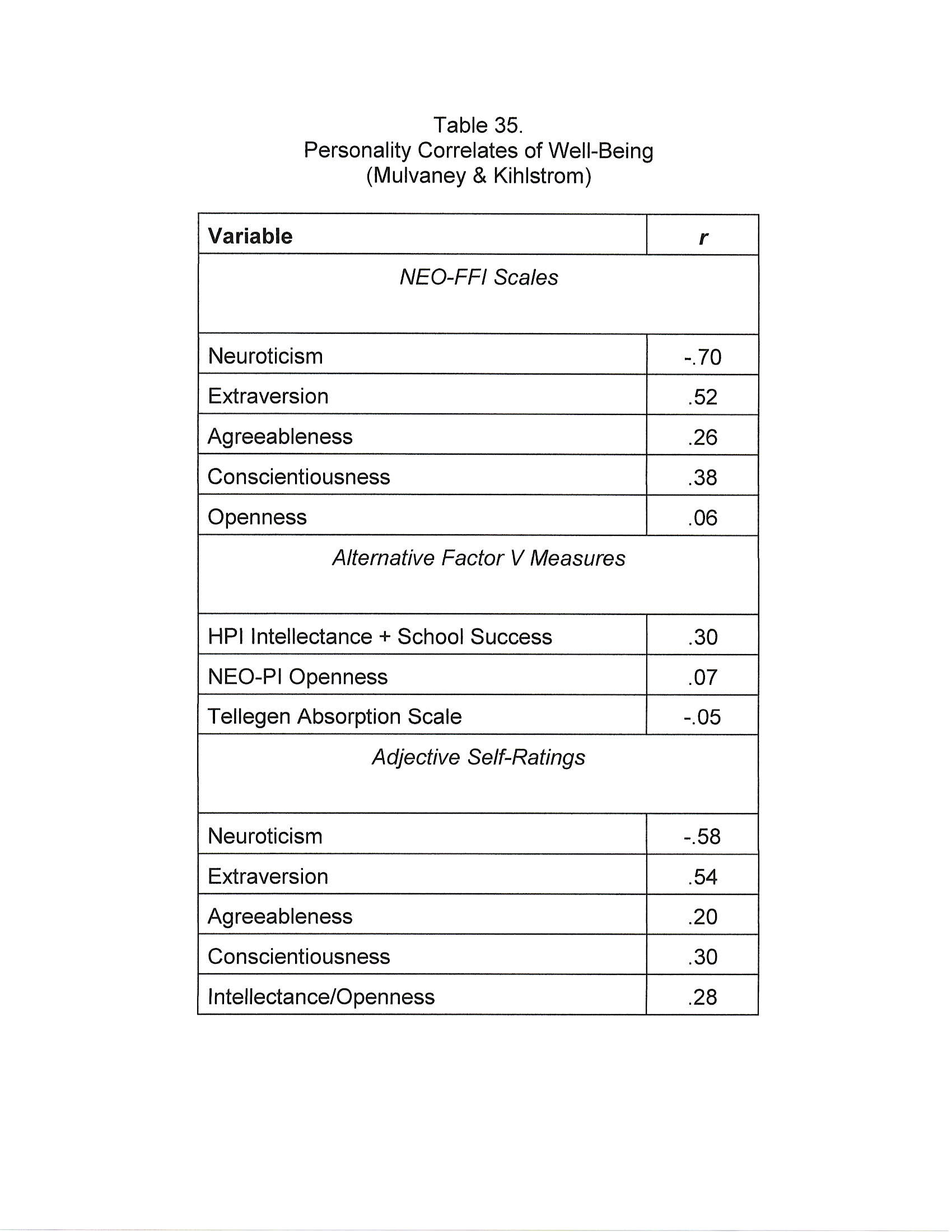 In
In 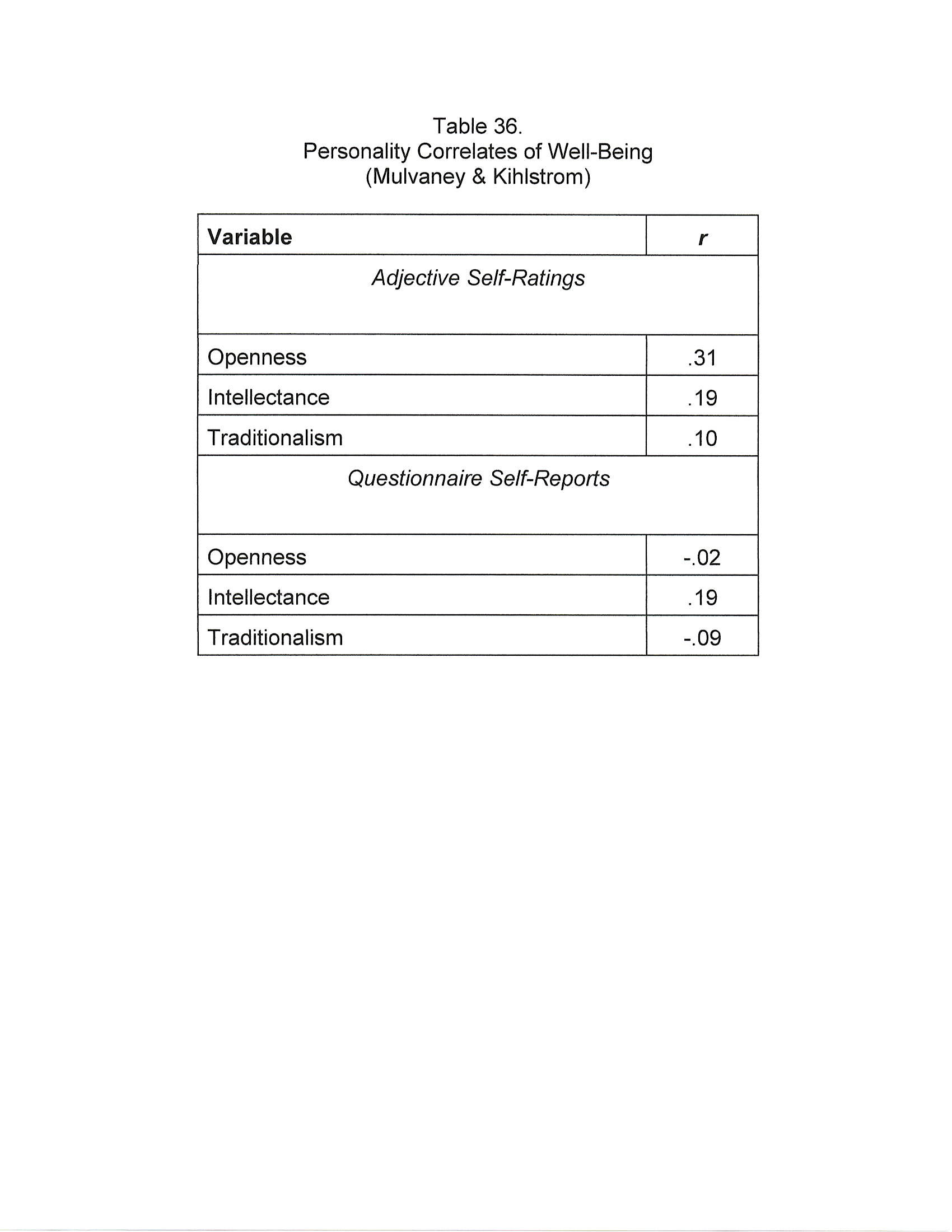 our study, we replicated the
McCosta findings for the
correlates of well-being: negative with neuroticism, naturally;
positive with extraversion, agreeableness, and
conscientiousness; essentially zero with
openness. But the NEO measure of
openness is complex, including absorption
and traditionalism, but no information about
intellectance. We got these
correlations as well. In the
self-report questionnaires, well-being was
correlated with intellectance (the sum of
HPI School Success and Intellectance
scales), but not with openness or
absorption. In the Trapnell clusters,
well-being was correlated with a
combination of intellectance and
openness.
our study, we replicated the
McCosta findings for the
correlates of well-being: negative with neuroticism, naturally;
positive with extraversion, agreeableness, and
conscientiousness; essentially zero with
openness. But the NEO measure of
openness is complex, including absorption
and traditionalism, but no information about
intellectance. We got these
correlations as well. In the
self-report questionnaires, well-being was
correlated with intellectance (the sum of
HPI School Success and Intellectance
scales), but not with openness or
absorption. In the Trapnell clusters,
well-being was correlated with a
combination of intellectance and
openness.
Based on our earlier factor-analytic work, we then constructed reliable measures of each aspect of Factor V. In the adjective self-ratings, well-being correlated with openness and intellectance. Traditionalism, however, mattered relatively little, failing to account for additional variance in a multiple regression. In the questionnaire self-reports, well-being correlated only with intellectance; it didn't correlate with absorption or traditionalism, which added nothing to the multiple regression. So, while there are some contradictions to straighten out, it appears that the three aspect of Factor V correlate differentially with emotional well-being.
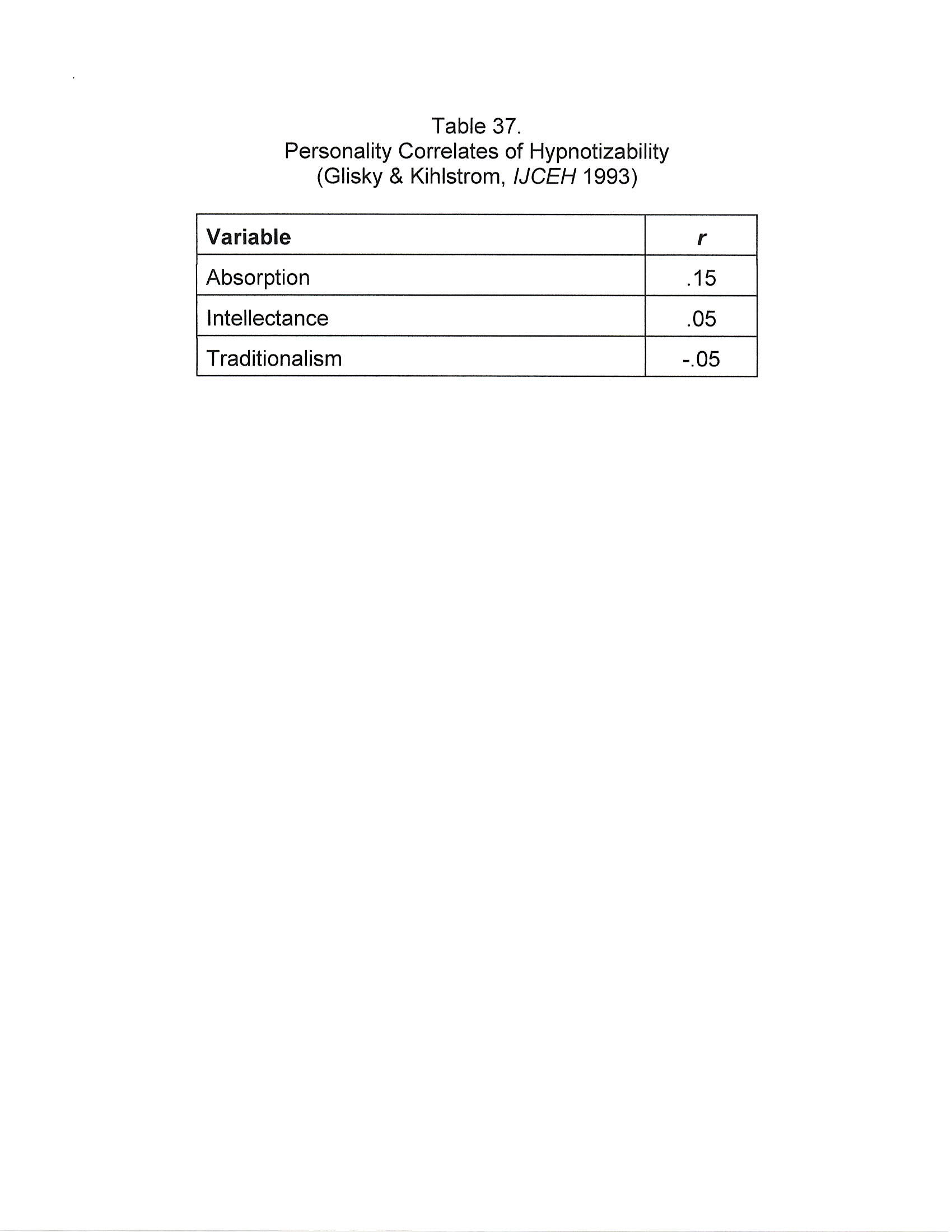 For
further evidence, we can return to where we began: the
personality correlates of hypnotizability. Again
based on our earlier factor-analytic work, Martha Glisky built two new
12-item scales of absorption, intellectance, and
traditionalism, and administered this to subjects prior
to receiving a
hypnotizability scale (Glisky &
Kihlstrom, 1993).
Hypnotizability correlated significantly with absorption,
but not with intellectance or traditionalism.
For
further evidence, we can return to where we began: the
personality correlates of hypnotizability. Again
based on our earlier factor-analytic work, Martha Glisky built two new
12-item scales of absorption, intellectance, and
traditionalism, and administered this to subjects prior
to receiving a
hypnotizability scale (Glisky &
Kihlstrom, 1993).
Hypnotizability correlated significantly with absorption,
but not with intellectance or traditionalism.
Although we still have a long way to go to digest all this data, we can arrive at some tentative conclusions.
First, the various construals of Factor V are not equivalent. In the questionnaire domain, we can make clear distinctions among absorption, intellectance, and traditionalism. Factor V seems to be represented somewhat differently, however, in the personality trait lexicon, which has lots of words for intellectance and traditionalism, but very few for absorption.
This evidence of heterogeneity emerges from internal analyses of personality measurements, but also appears to be confirmed in patterns of differential correlations with emotionality and hypnotizability.
Frankly, I am edging toward the conclusion that the Big Five might not be the Big Five after all. It might be something closer to the Big Seven
- Extraversion
- Agreeableness
- Conscientiousness
- Neuroticism
- Intellectance
- Liberalism
- Absorption
All three aspects of "Factor V" meet criteria for inclusion:
But we certainly need more evidence on this score, with respect to the coherence within each dimension, independence of other dimensions, and differential external validity.
One remaining question: Can you do this with any of the Big Five? There is precedent for this question: J.P;. Guilford, in the paper whose title inspired my own, split extraversion into ambition and sociability -- a move followed by Bob Hogan as well. I think there is a legitimate question about how closely the other four factors hang together, if we added items, as we did in our studies, to represent their various construals more adequately.
In any event, I think it's now clear that Factor V doesn't hang together well at all. "Openness" is a hotchpot of three to five very different attributes:
As the field moved toward general acceptance of the Big Five, Factor V was always the most slippery and controversial. We now understand that this controversy arose for good reason.
But there's a more subtle question, which may be more important. Notice that "absorption" doesn't come out clearly in the Goldberg 1710 data set, but is clearly represented in self-report questionnaire items. There's no such discrepancy with respect to intellectance or liberalism. Why isn't absorption clearly represented in the trait lexicon? Maybe because it's not as socially important as intellectance and liberalism. It may not be one of the "Blind Date" questions after all. Absorption is, essentially, a private experience, not manifest in publicly observable behavior. Here's an illustration, I think, of a correlate of Zipf's Law: words don't evolve when things aren't discussed.
This
suggestion, in turn, raises the question
of whether there aren't a whole host of
important personality dimensions that do
not manifest themselves in publicly
observable behavior, and that therefore
aren't necessarily represented in the
language we use for interpersonal
communication. If so, then
analyses of the structure of personality
based on either the trait-state lexicon
or publicly observable
behavioral acts will be necessarily
misleading. It's possible
that as our culture changes, as we
become more or less introspective,
or self-involved, this situation
will change. But for now, we
should be clear about the
sociocultural foundations of a
structure of personality that we all
would like to think of as universal.
Another
possibility is that absorption simply
isn't socially important enough to be
represented much in language.
At least not yet. It's possible
that the Big Five, or at least this
dimension of the Big Five, isn't
universal after all, and that the
nature of Factor V has changed with
time. Perhaps,
before World
War II (Cattell) and
immediately thereafter
(Fiske's VA study), "intellectance"
-- appearing, and maybe being,
smart -- was socially
important, and so it entered the Big
Five. In the 1950s, with the expansion
of the middle class and increasing
numbers of students going to
college, maybe "culturedness" became
important. And then with the
social revolution of the 1960s, and
the more recent emphasis on
multiculturalism, "openness" entered
the picture. If
so, and Factor V isn't universal
with respect to time and place,
investigators are going to have
to decide which construal of that dimension is
most important for their
purposes.
This webpage last updated 05/25/2016.